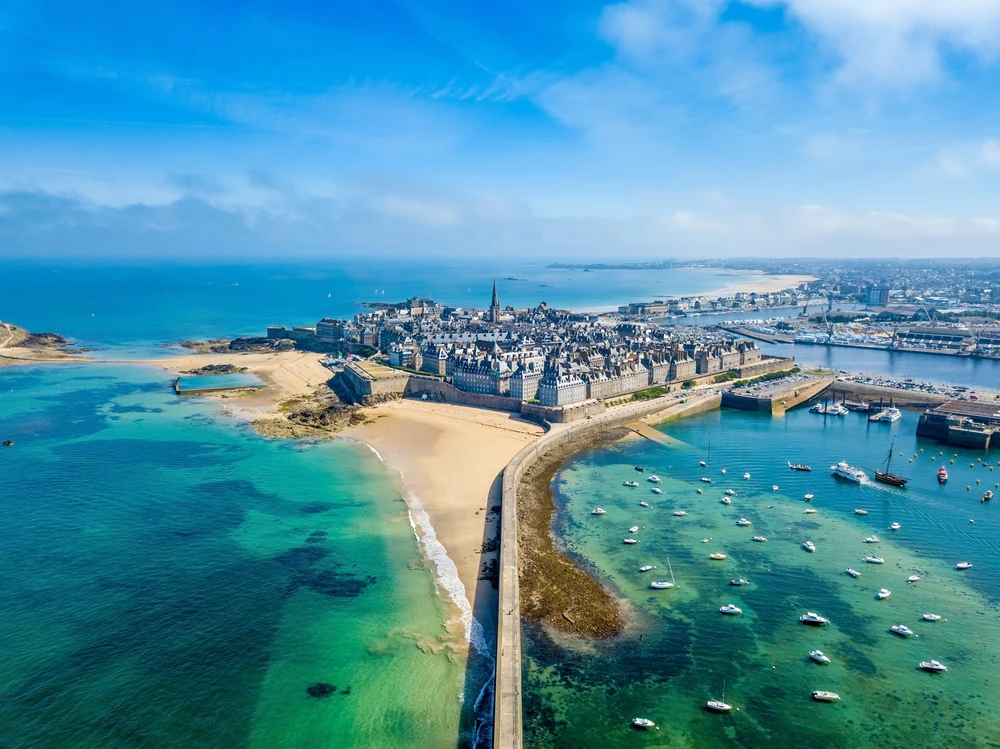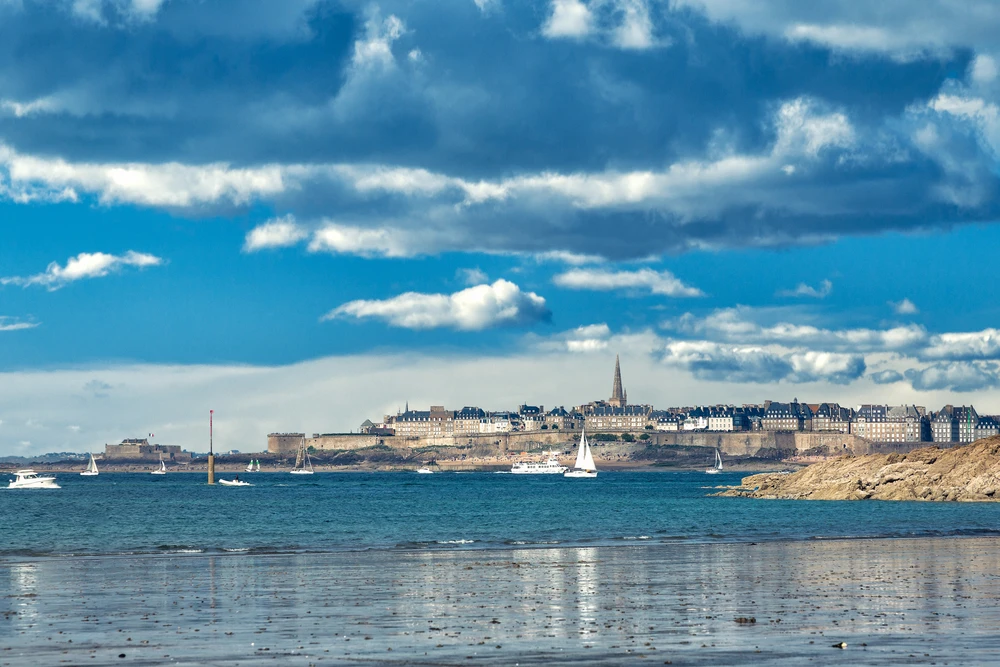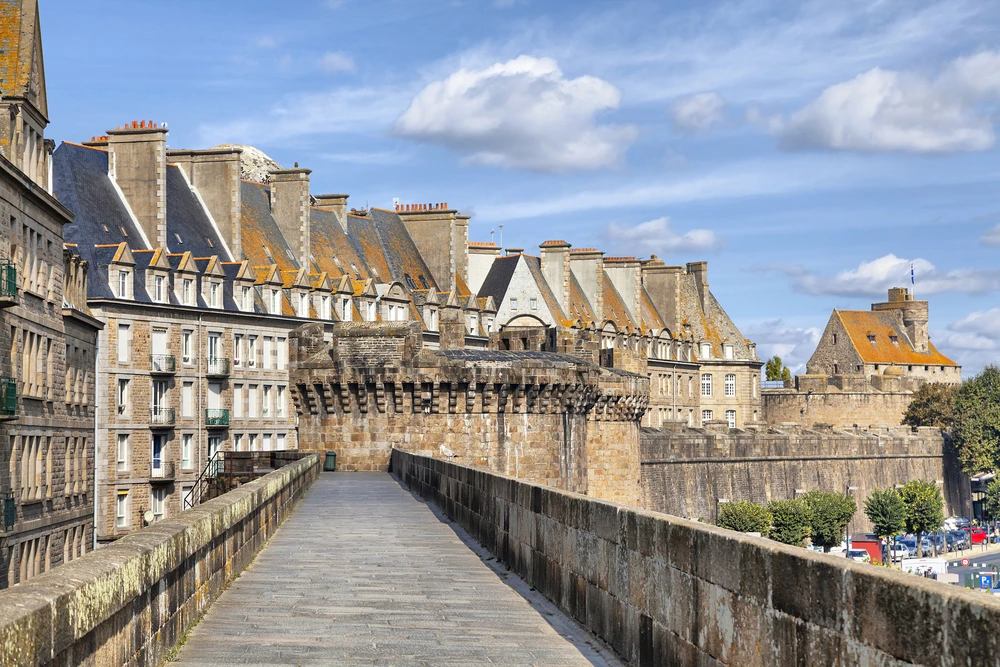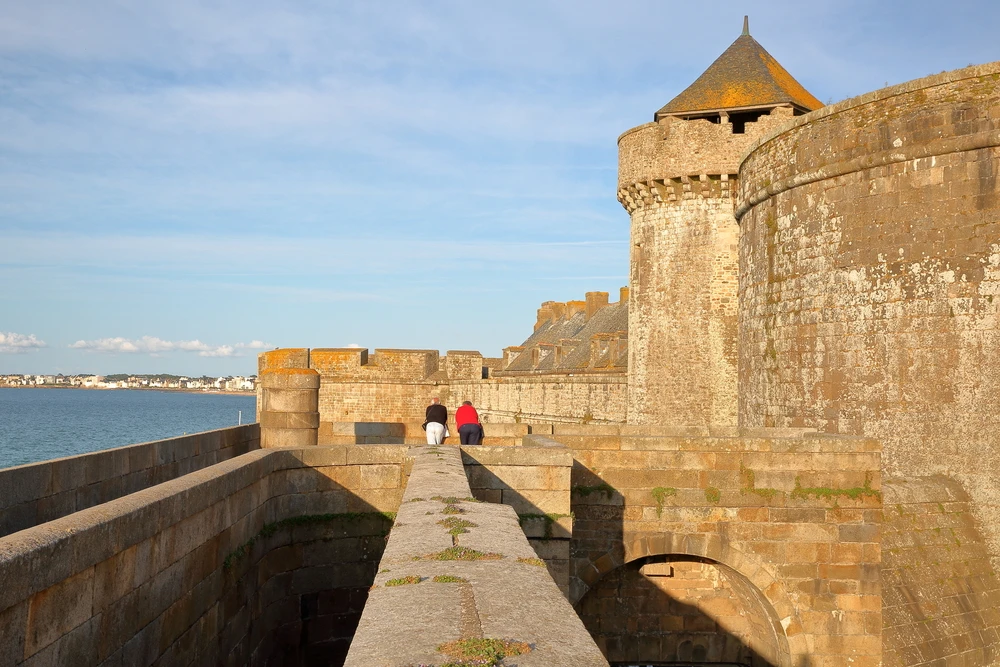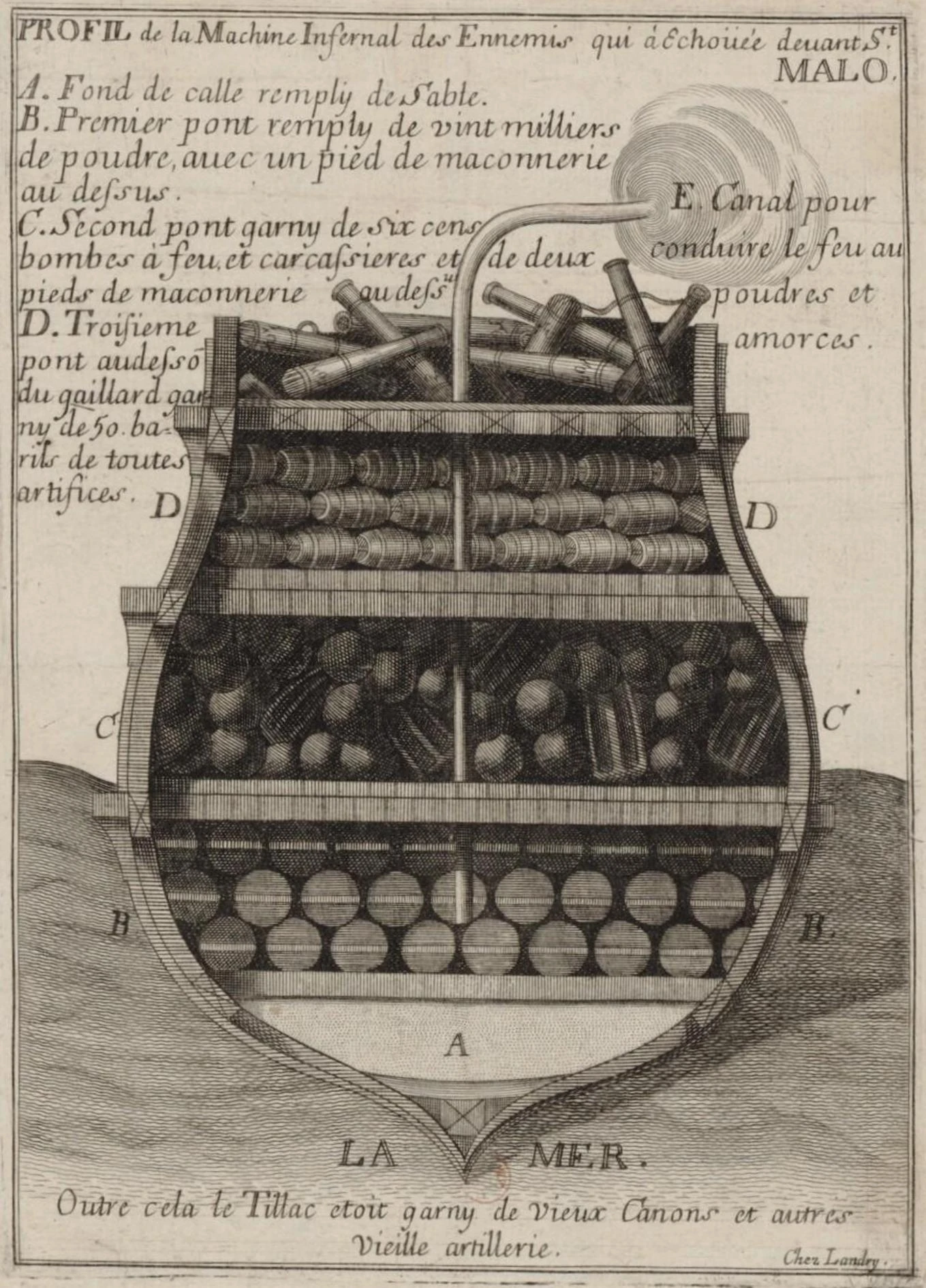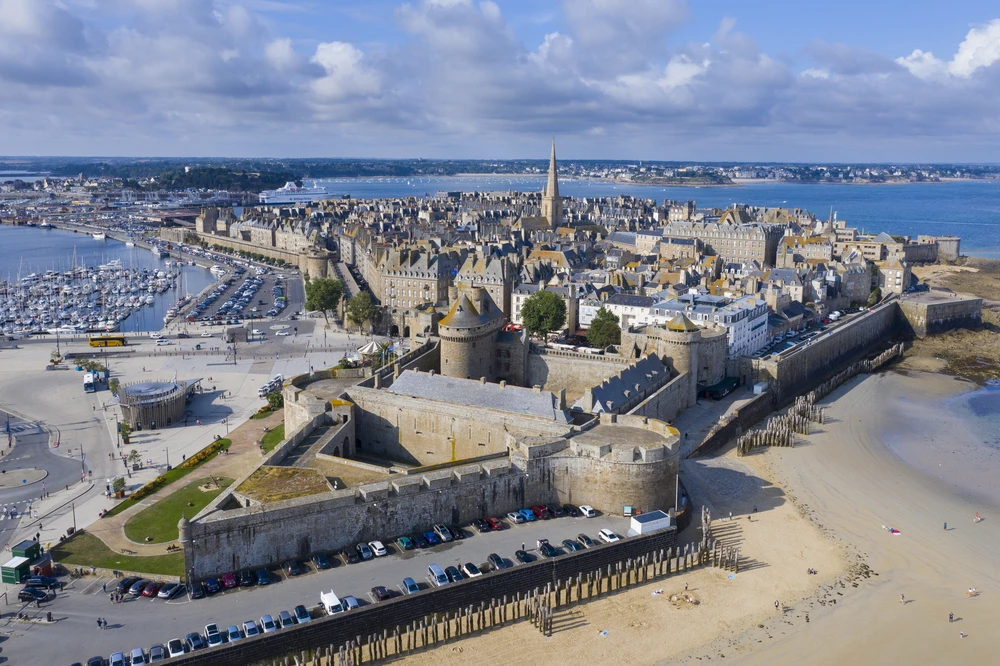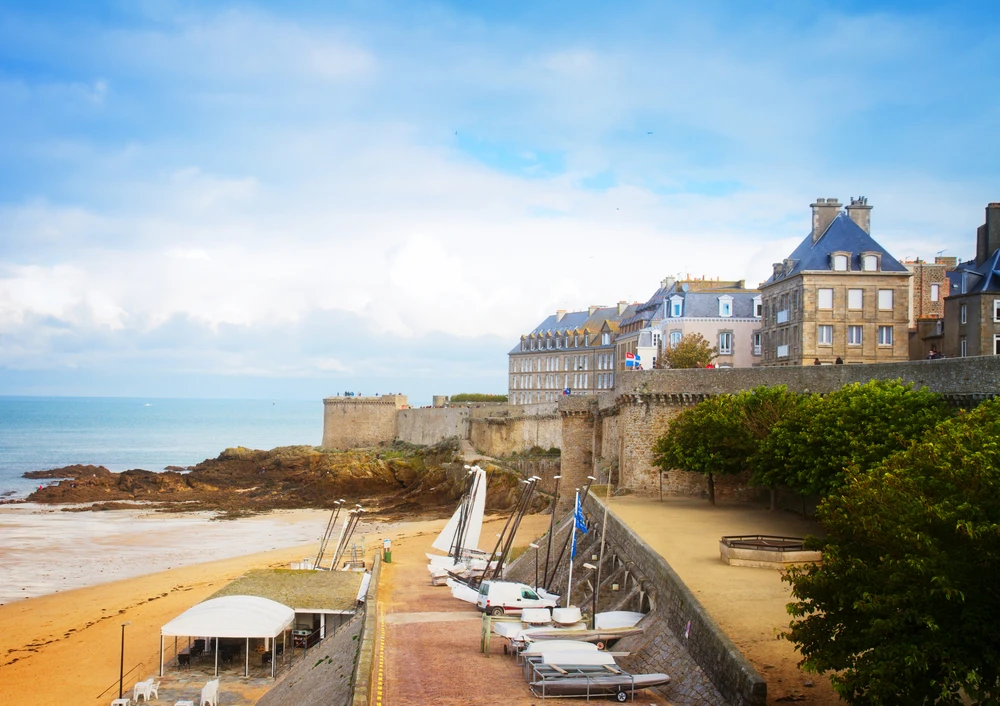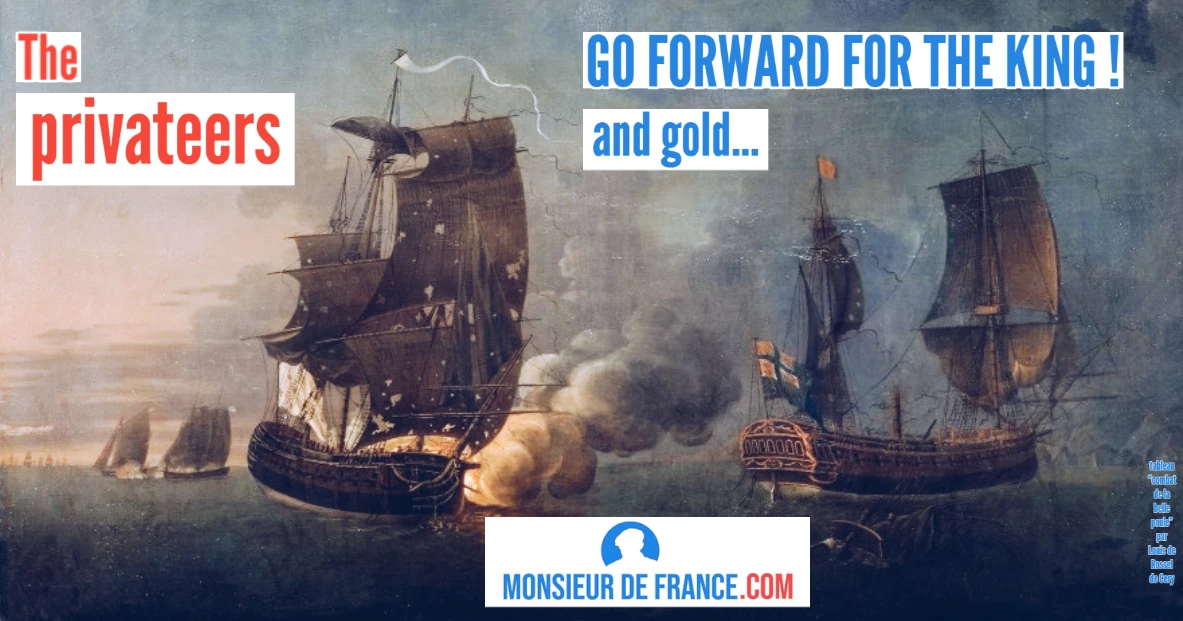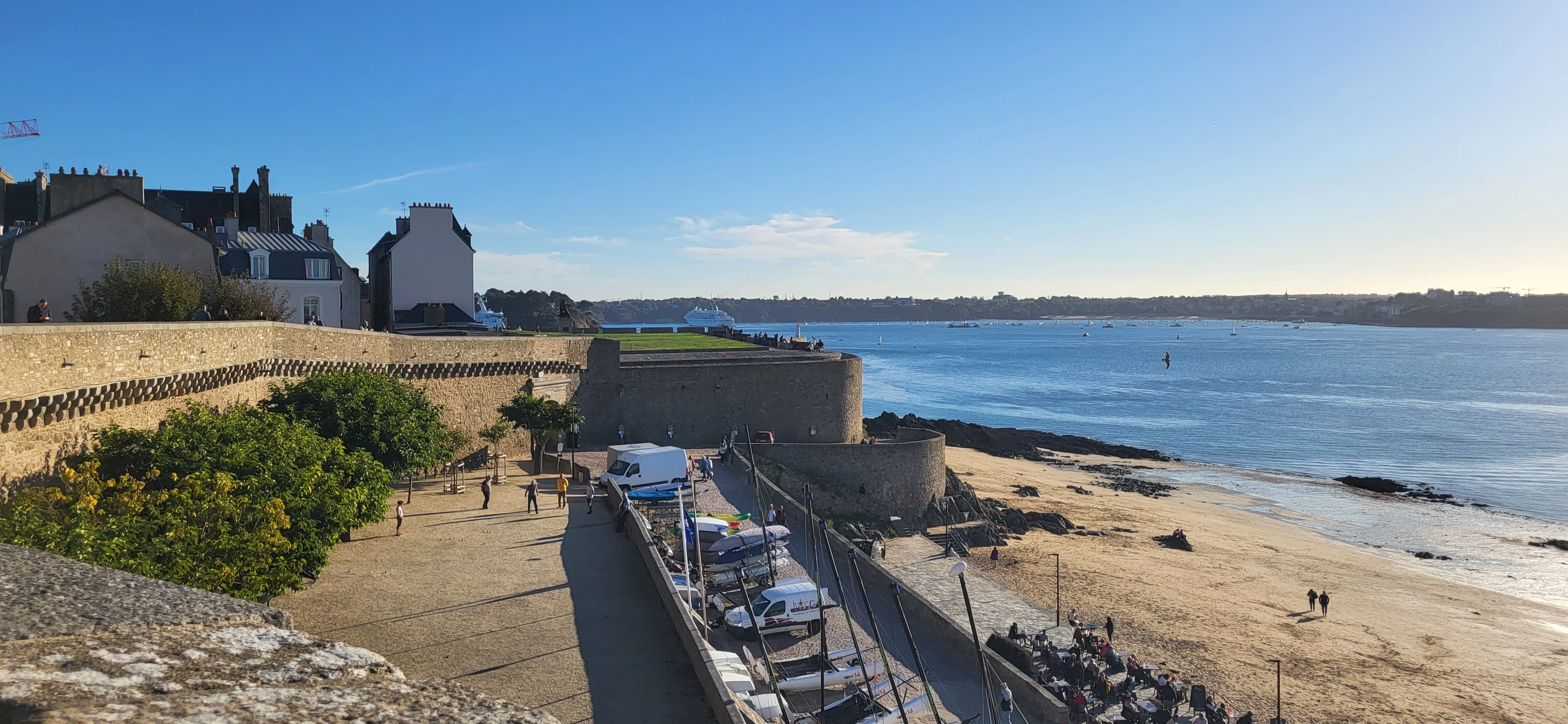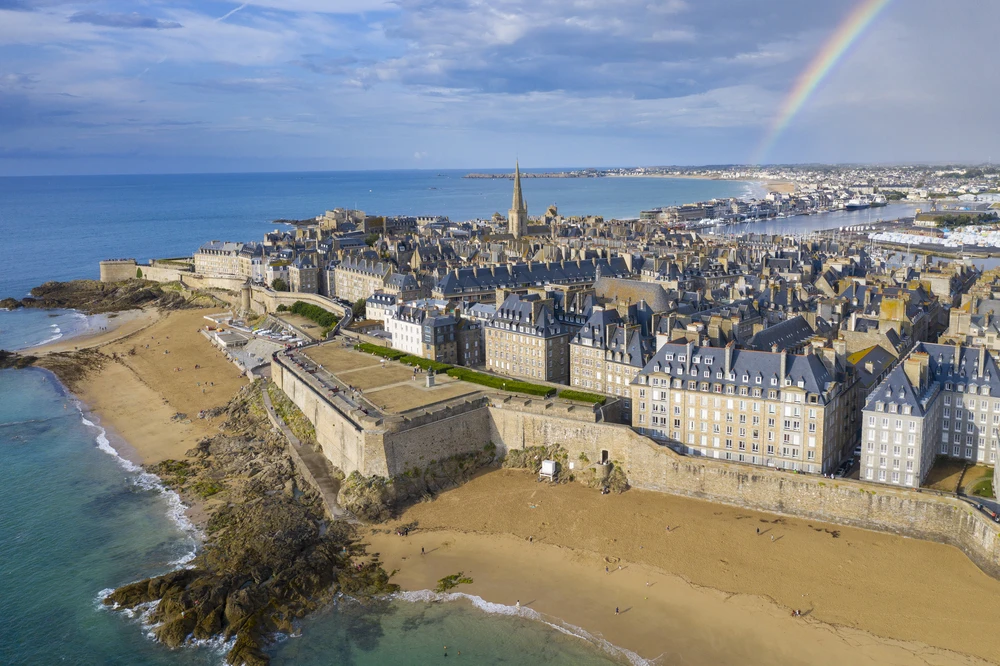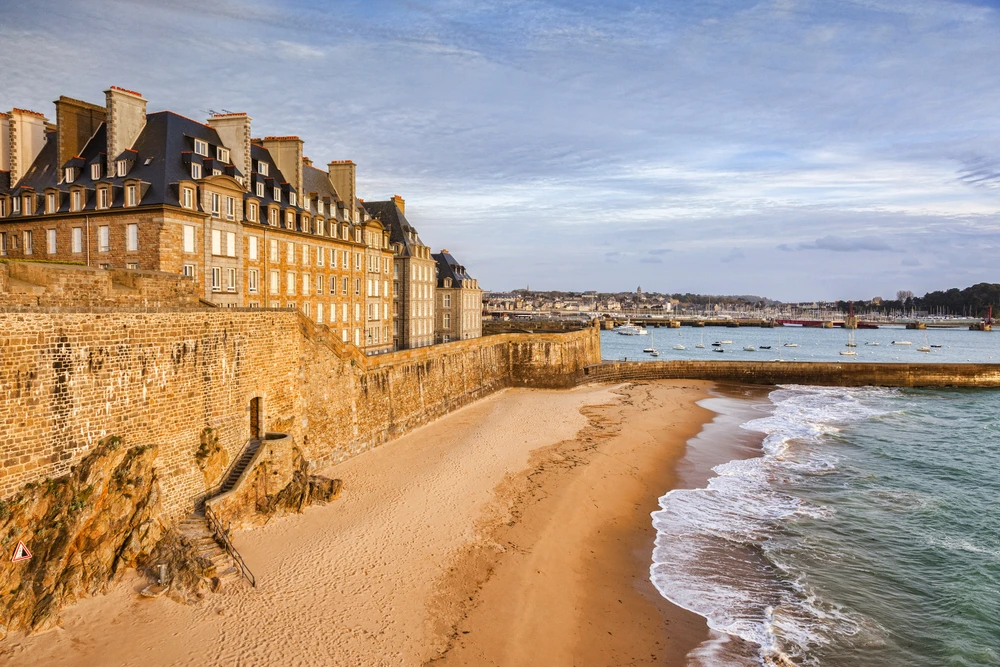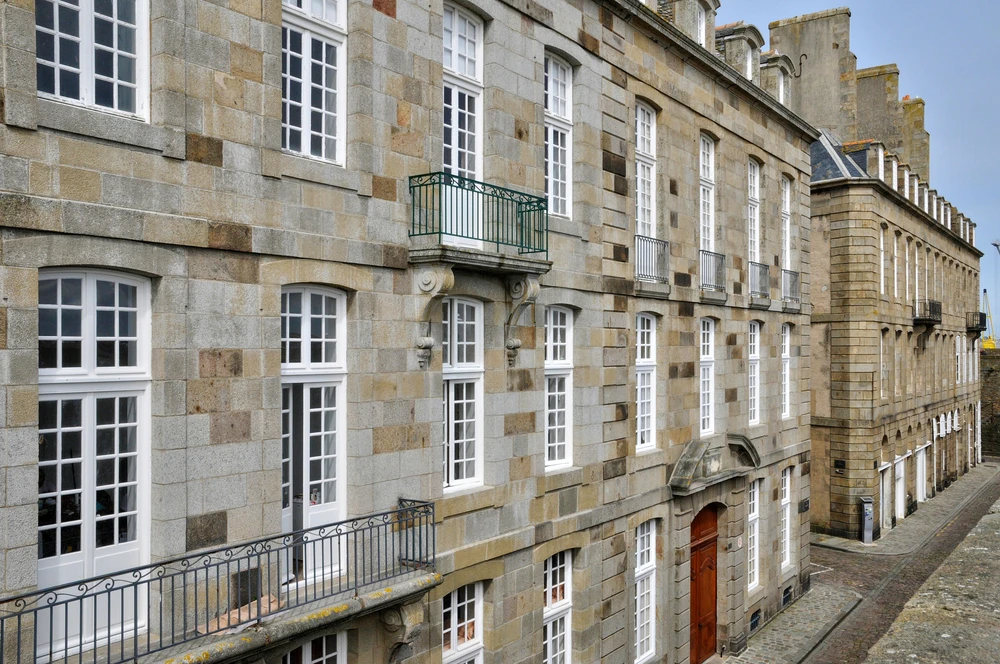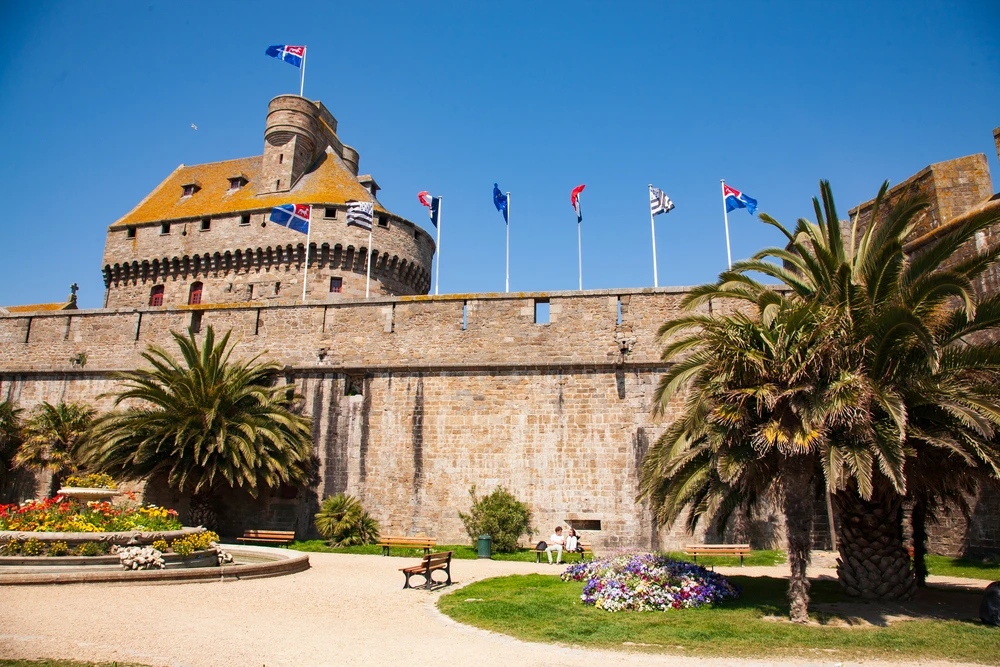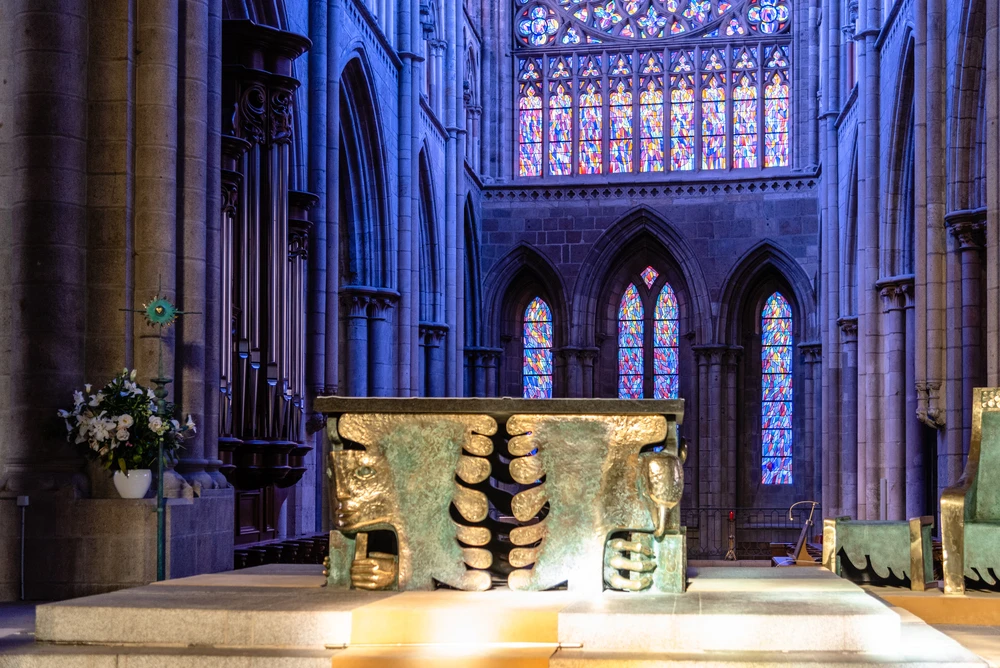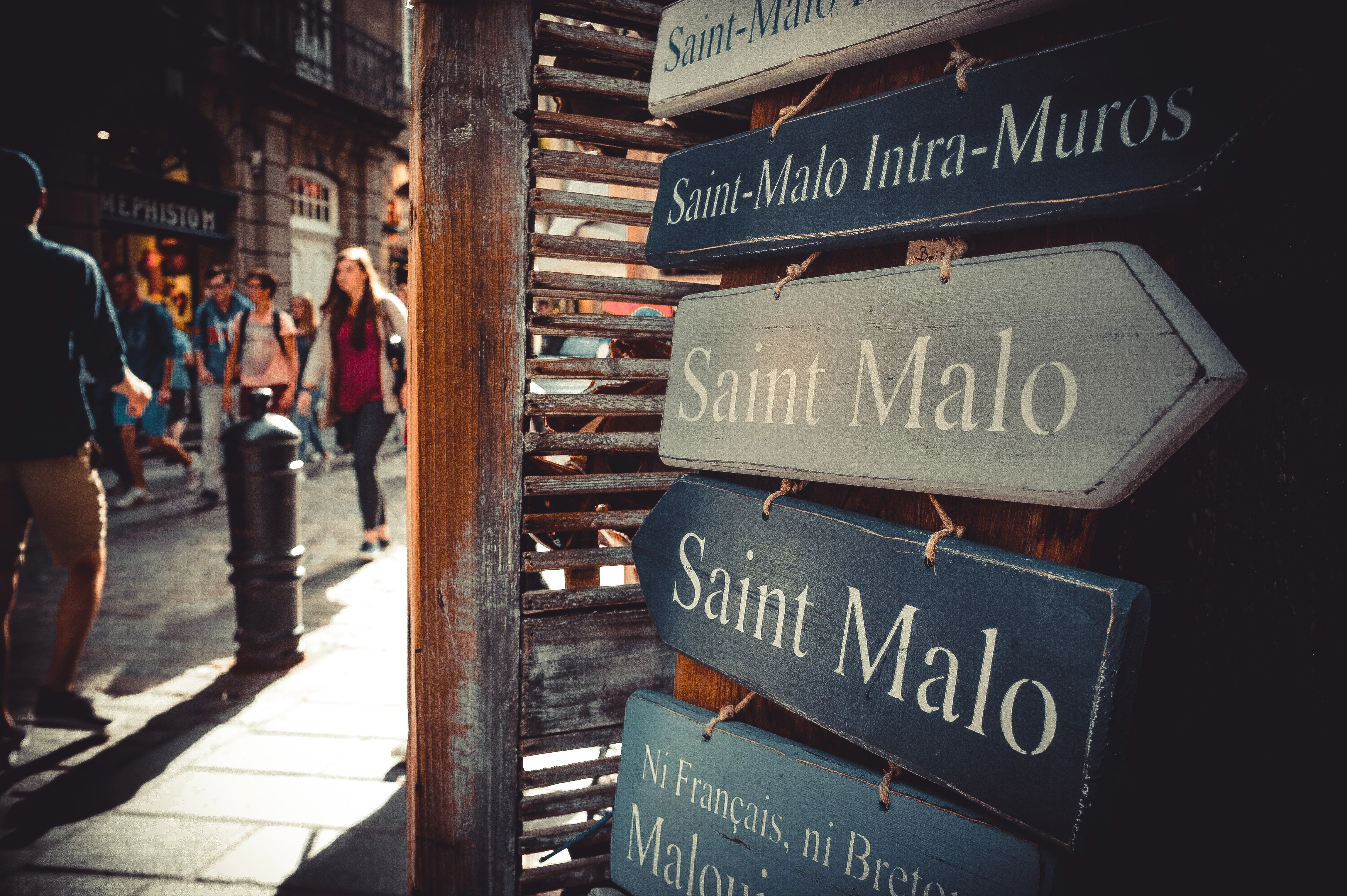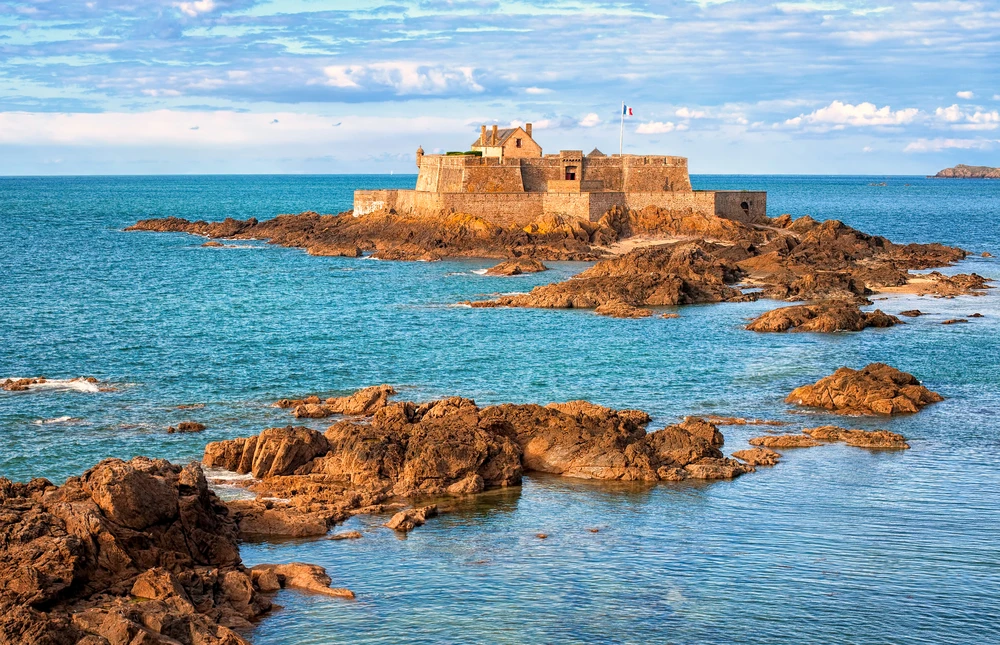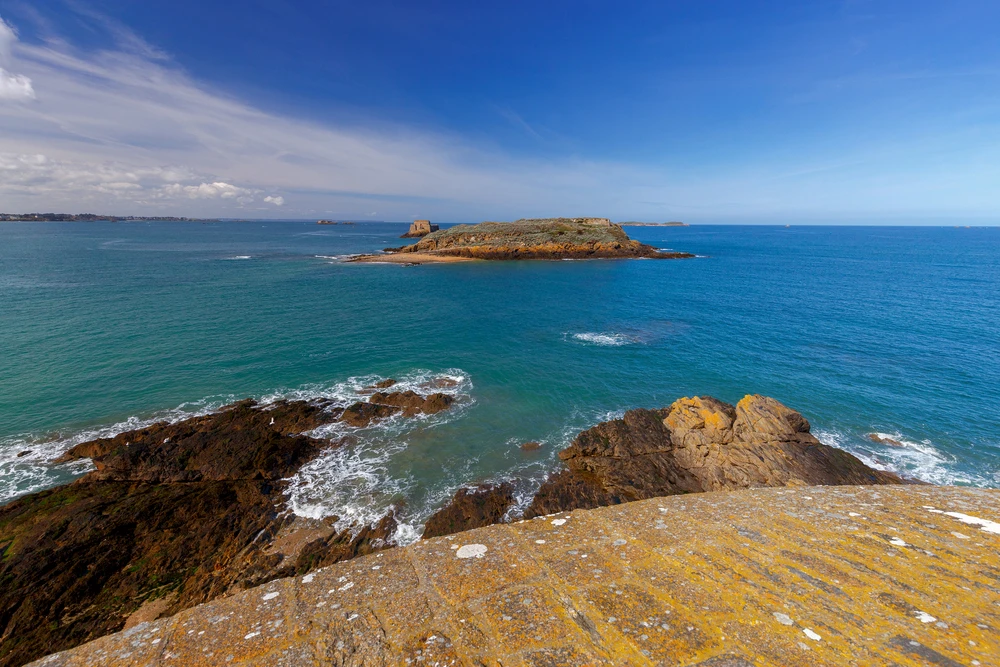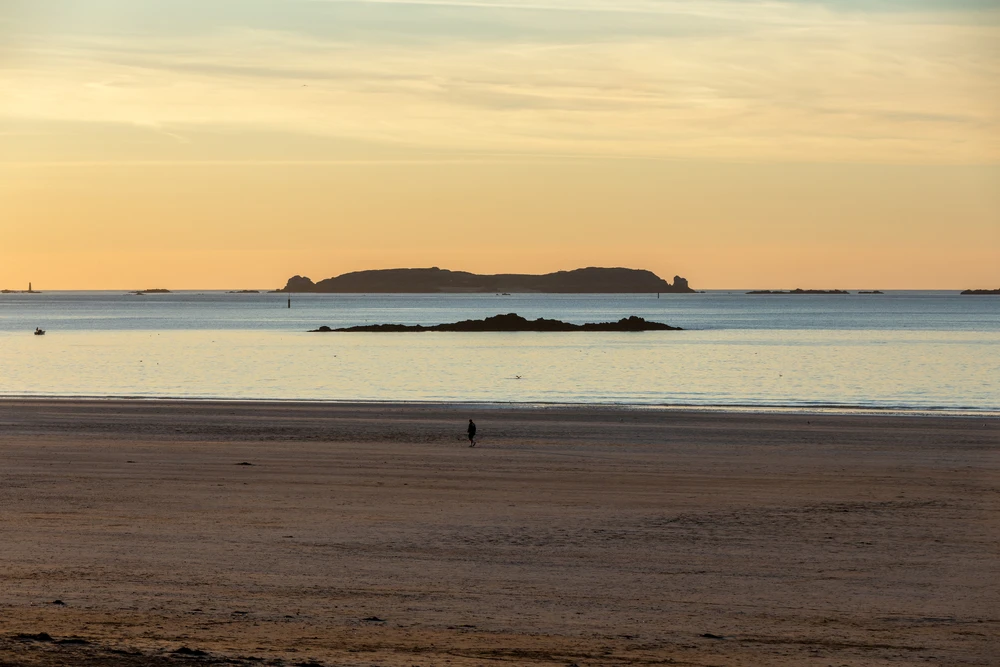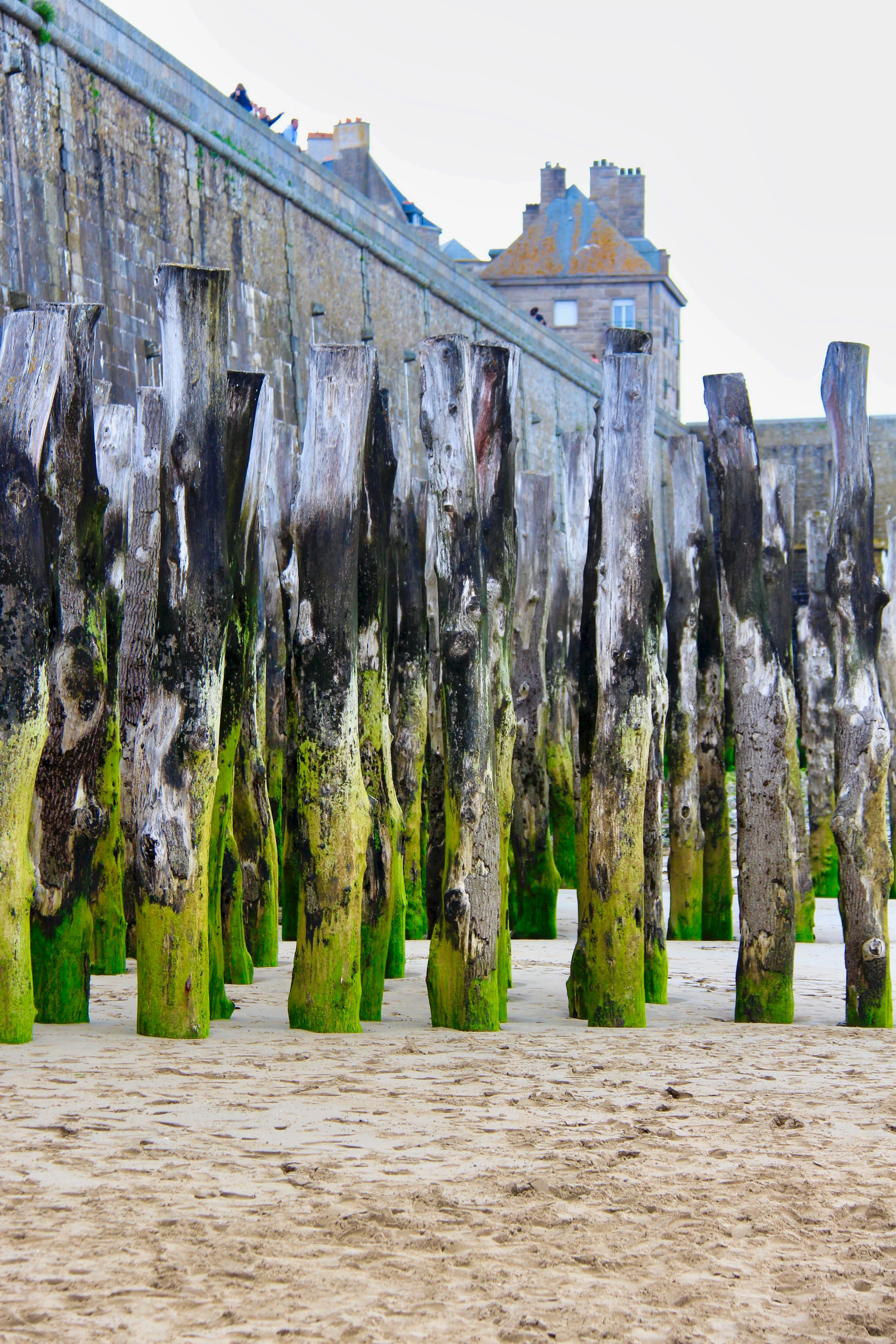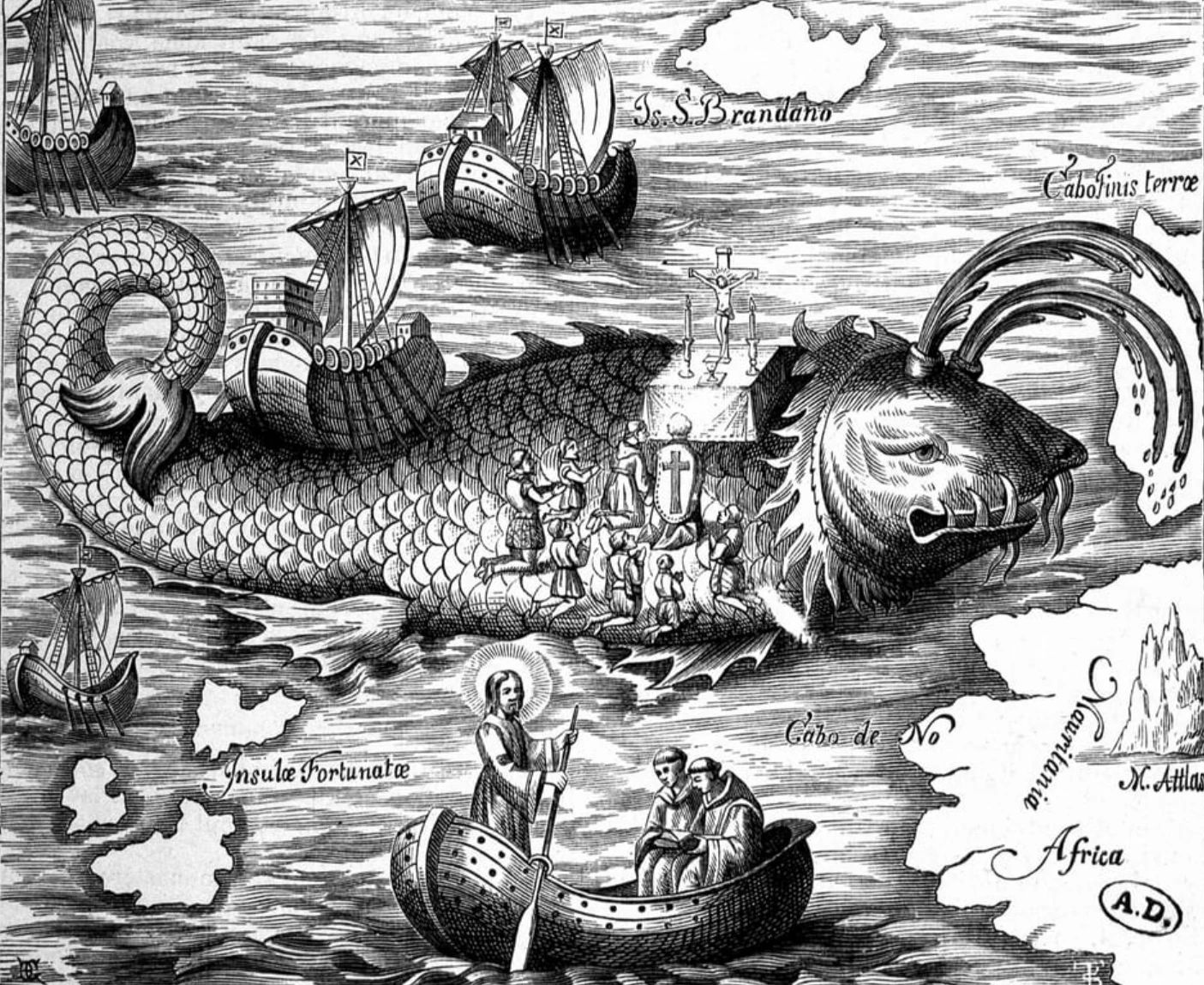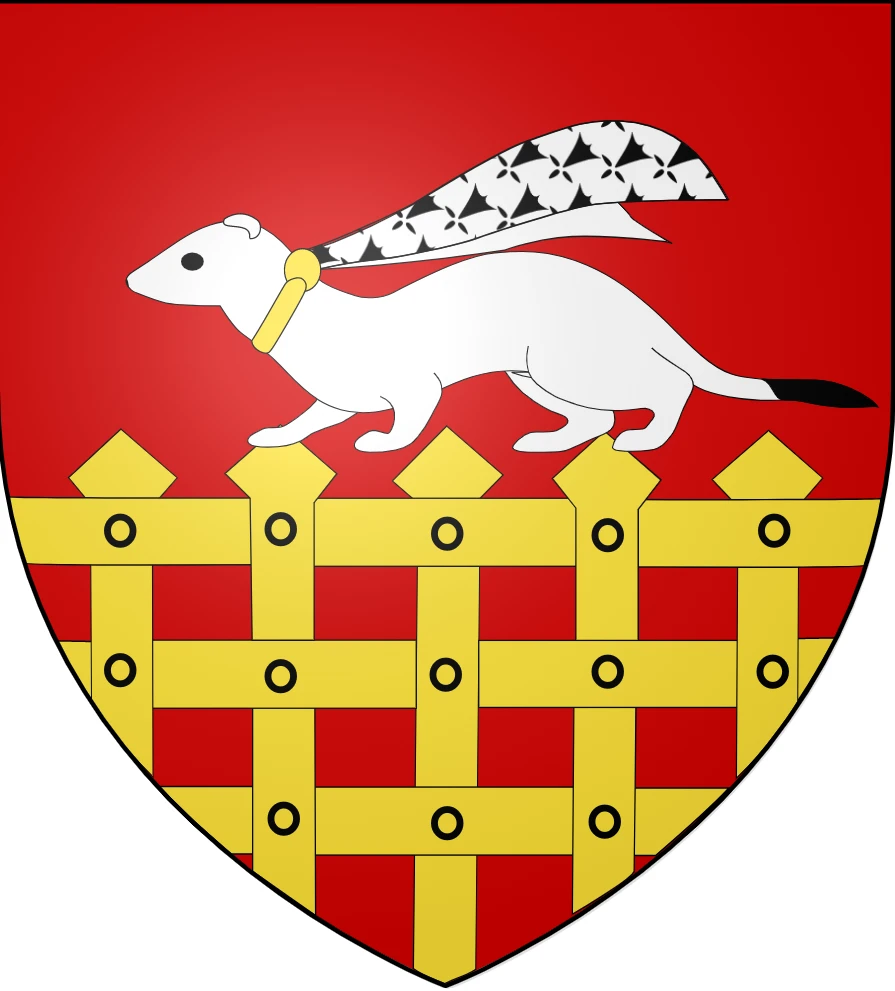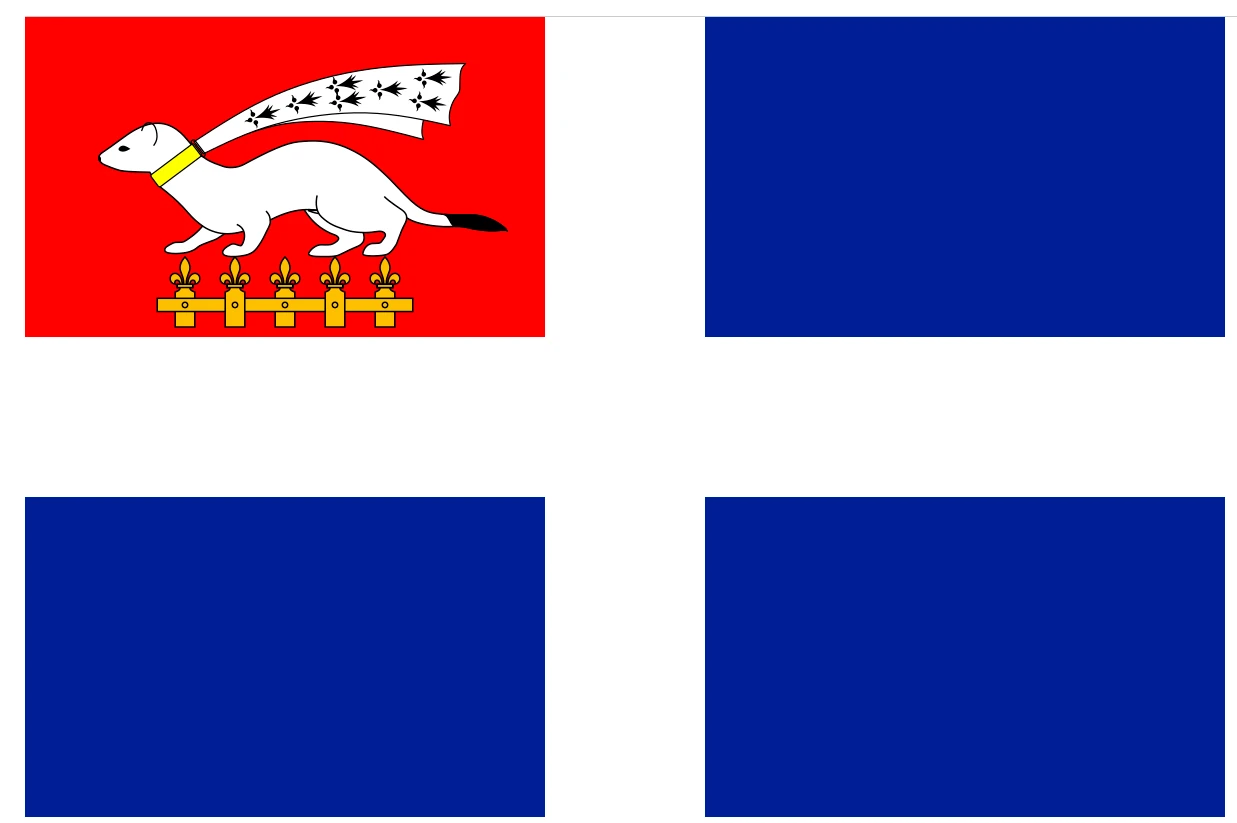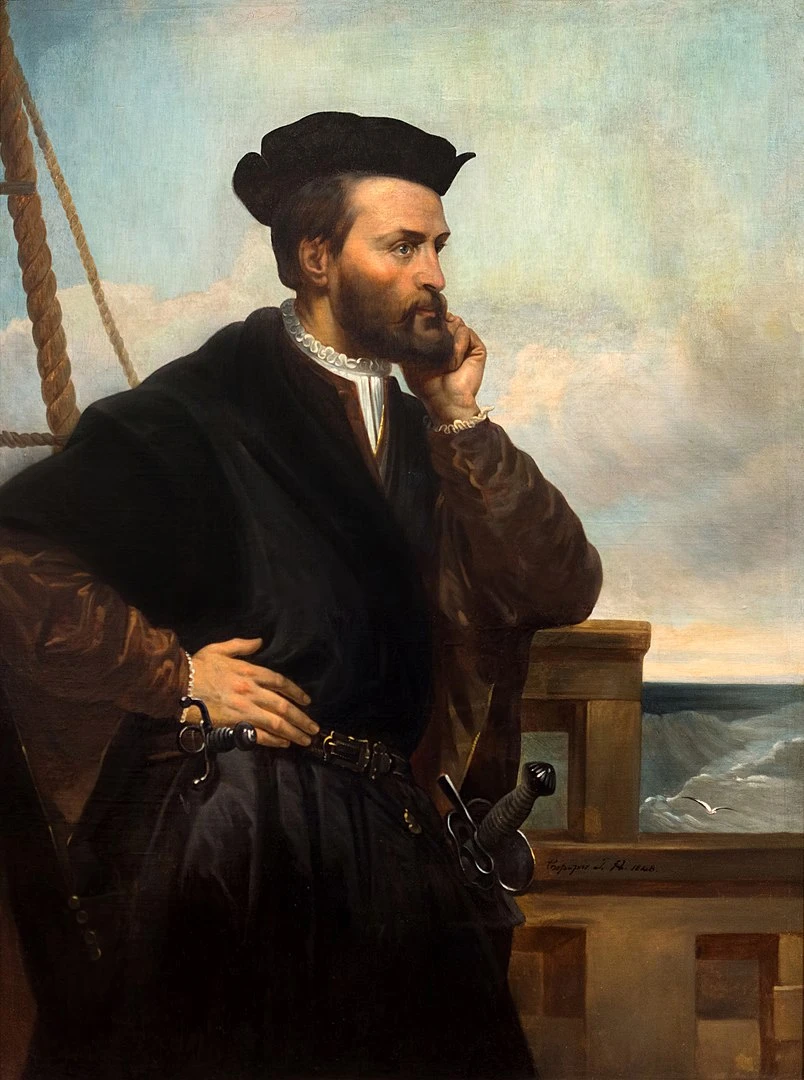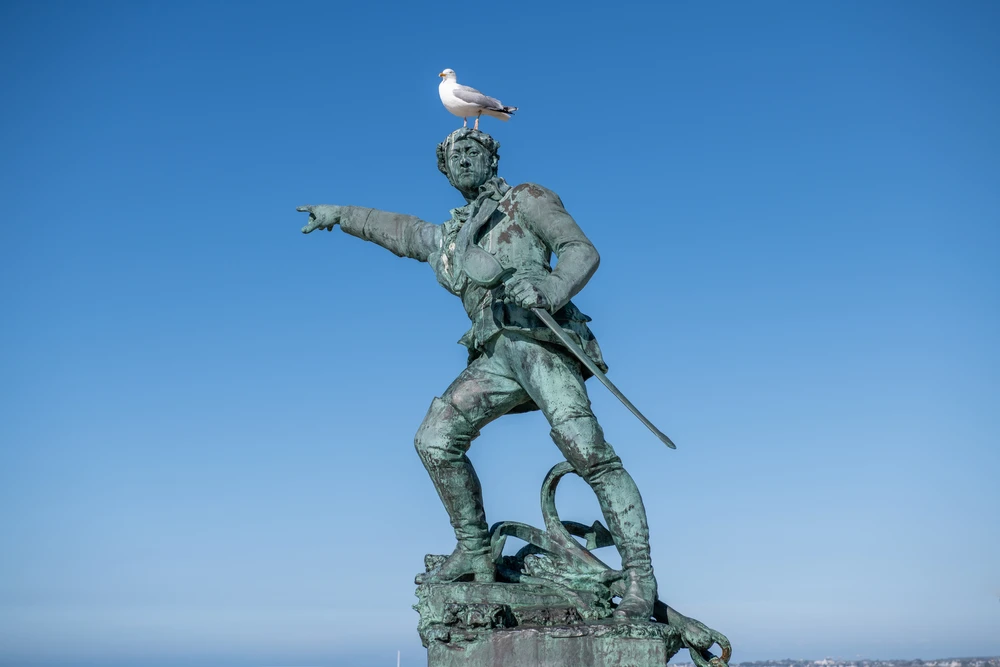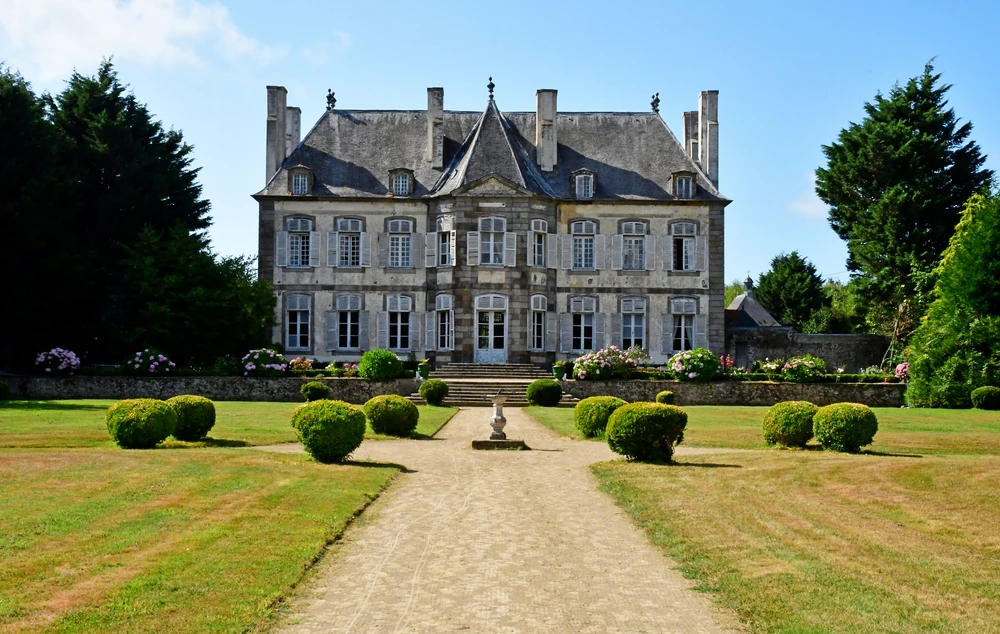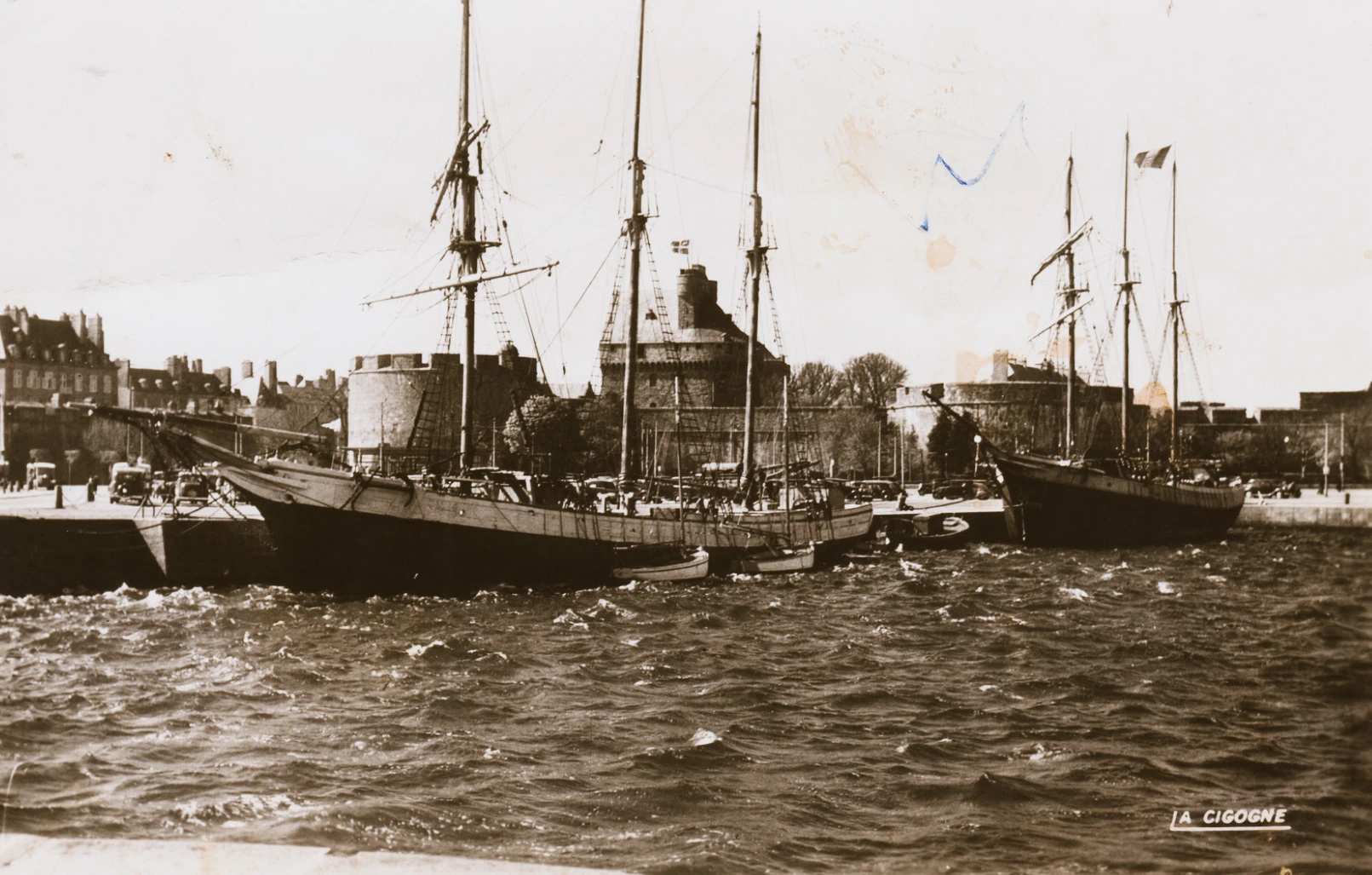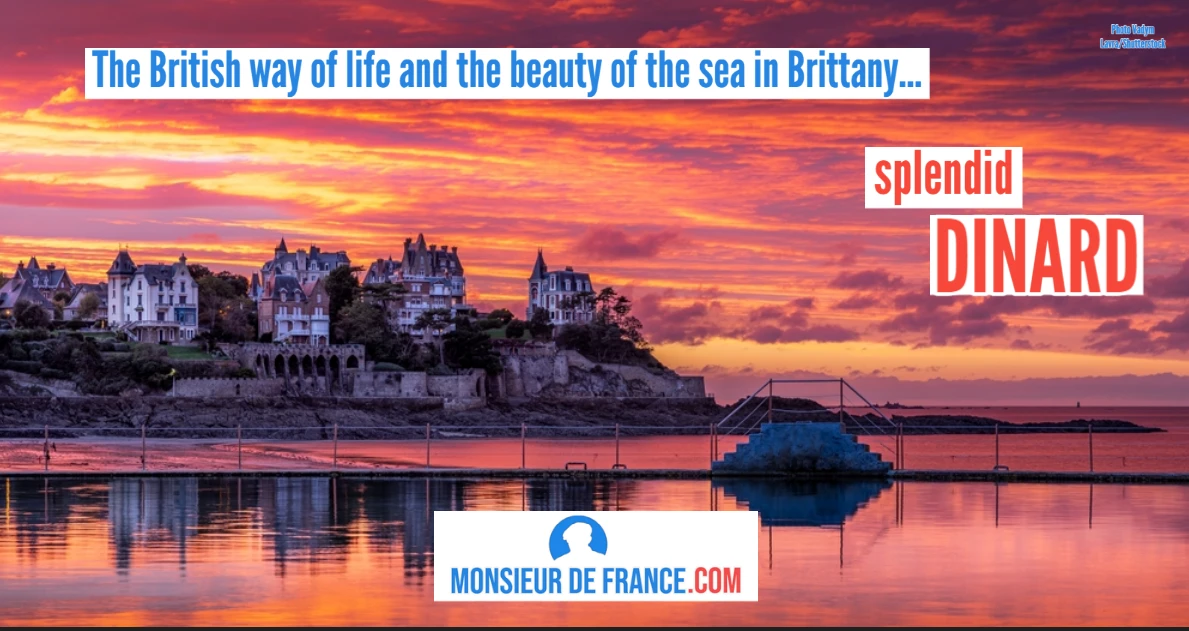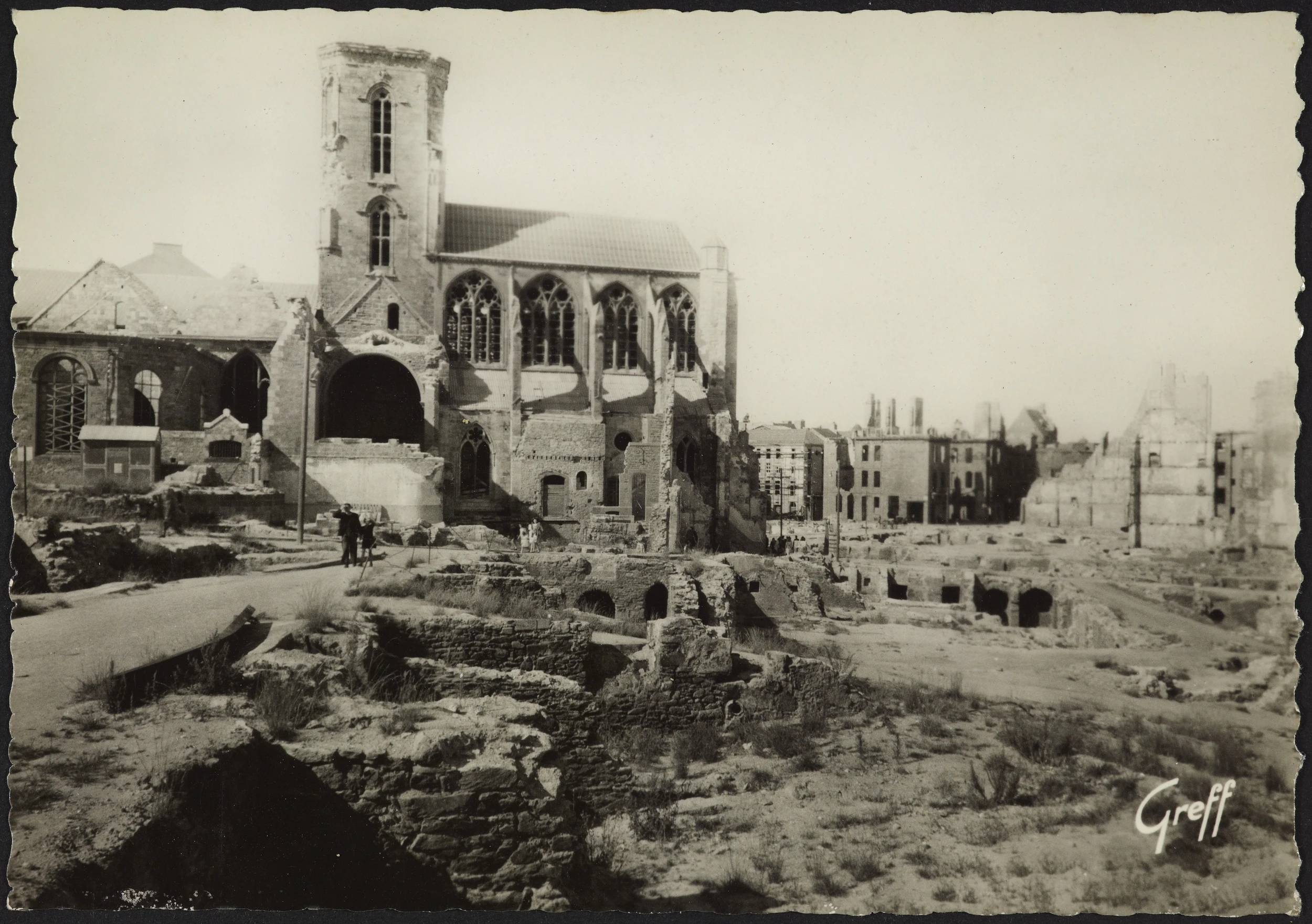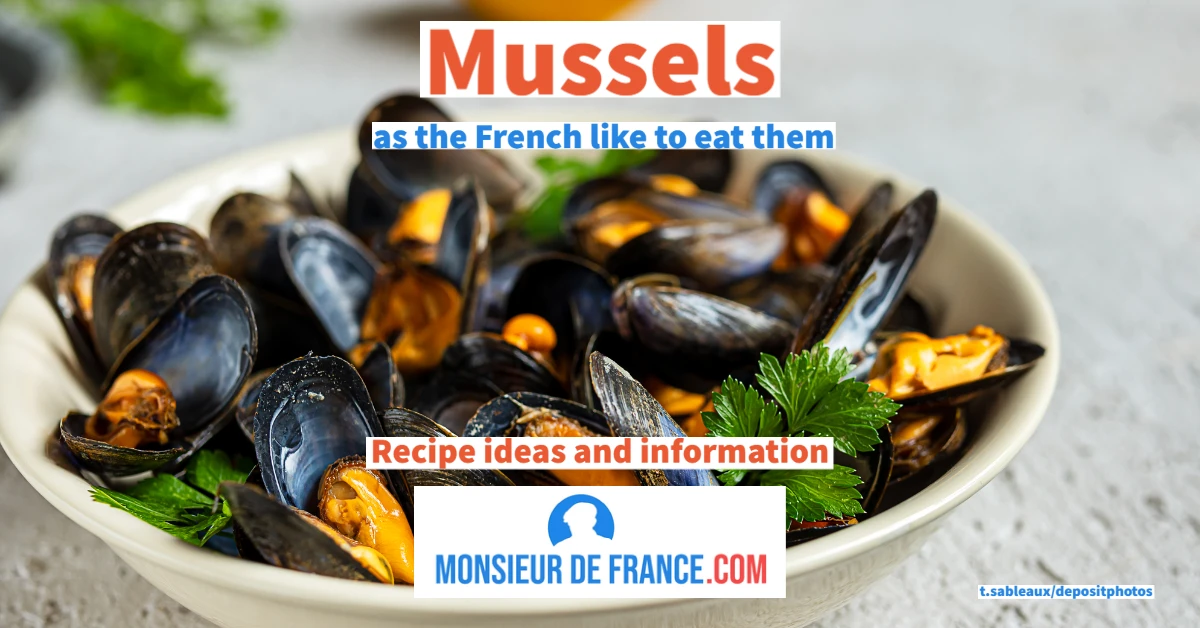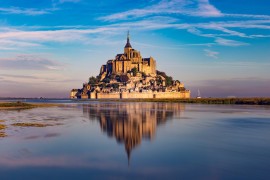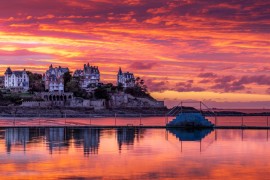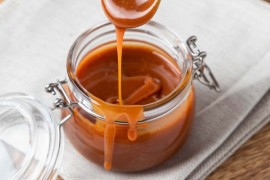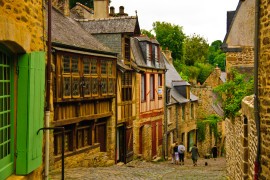Stopover at Saint Malo! The Gauls were already doing this at the town of Alet. What does this have to do with Saint Malo? In the 10th century, tired of being pillaged, ransomed or killed, the inhabitants moved from Alet and settled on a huge rock connected to the land by a strip of sand that the sea covers twice a day, called the Sillon.This rock was once home to a certain Saint Malo, a monk who came from Ireland on the back of a whale (which some say he didn't notice at first), and who gave his name to the place. Over time, Saint Malo took shelter behind high walls and became a fortified port facing the sea. Having the sea all around you makes you curious. It was from here that Jacques Cartier set sail in 1534, discovering Canada. He was followed a century later by the seagull-light privateers of the 17th century, who, in the name of the King of France, attacked the windy vessels of the King of Spain or the King of England. So much so that the English nicknamed Saint Malo "the hornet's nest" . In peacetime, the shipowners (who also armed the privateers) did business all over the world. They became so wealthy that they gave us this magnificent city of stone, with its waltz of all shades of grey , and impressed Louis XIV himself, who respectfully nicknamed them "ces messieurs de Saint Malo" (which is also the title of a superb saga written by Bernard Simiot, which I recommend you read on the beach during your stay).
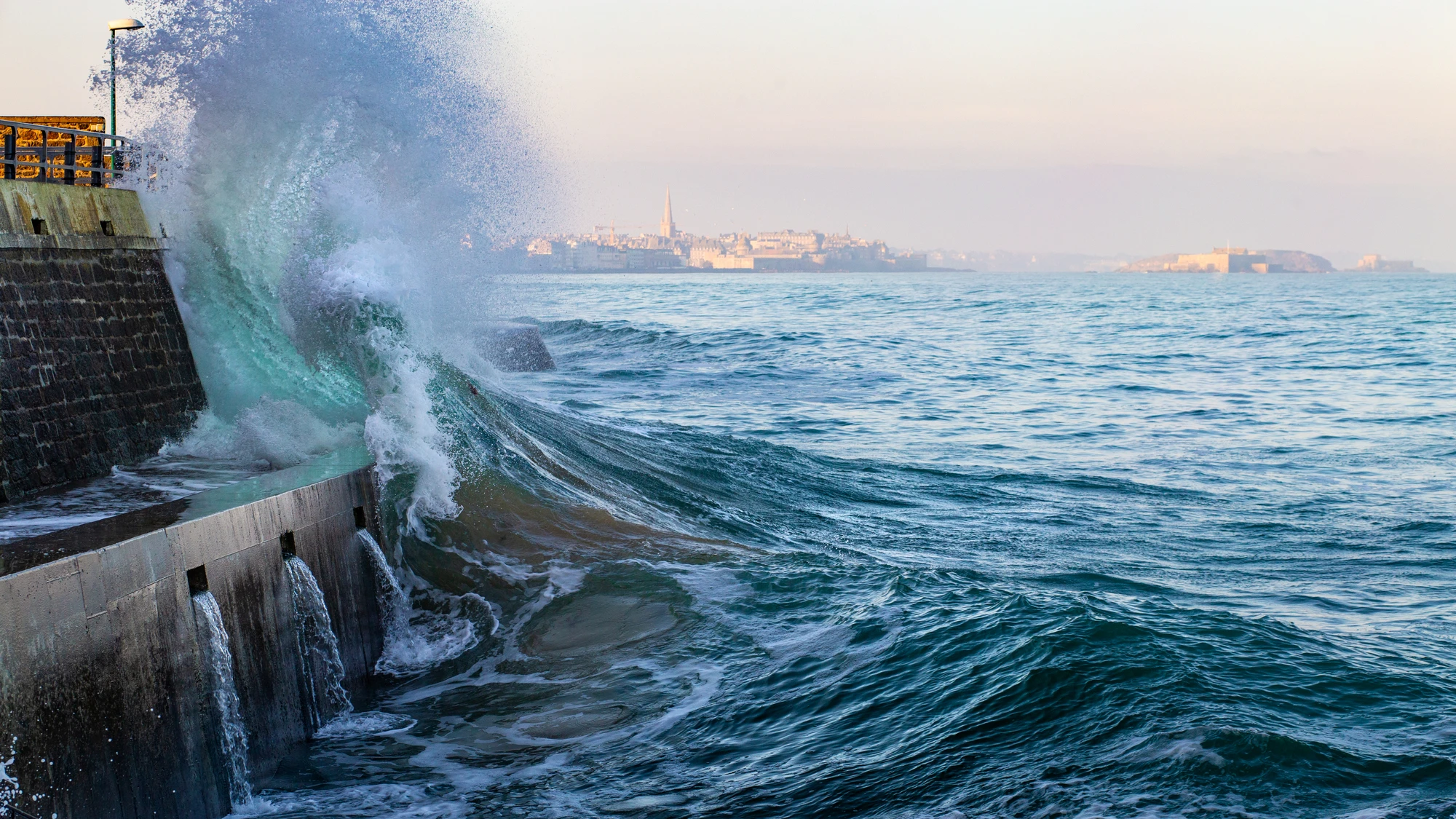 Saint Malo and the sea hitting the Sillon dike during high tides. Photo chosen by monsieurdefrance.com: depositphotos
Saint Malo and the sea hitting the Sillon dike during high tides. Photo chosen by monsieurdefrance.com: depositphotos
Saint-Malo was the port of departure for the terre-neuvas, the brave lads who toiled for months on end on the banks of Newfoundland, off the coast of Labrador, to bring home tons of salt cod, the only fish that could be eaten miles from the ocean.Today, it's the departure point for the last of the modern-day adventurers, the sailors who set off every four years on the Route du Rhum to reach overseas France from European France.Almost entirely destroyed in 1944, the historic town has been rebuilt in its original style, and its allure seems eternal: horizontal, surrounded by ramparts from which rise tall stone houses, so tightly packed together that they almost stick together in the wind. Saint Malo is also a pure tourist delight, from the beaches of the sillon to the marine thermal baths, from strolls through the Vauban forts to the sentier des douaniers, not to mention the culinary feast of lobsters, spiders and buckwheat cakes. Saint Malo is a great city, with a fascinating history and captivating beauty, anchored by the sea but always ready to discover the future.
What to see in Saint Malo
From Dinard (opposite Saint Malo), you can clearly see "intra muros", the historic city of Saint Malo surrounded by ramparts, with only the steeple of Saint Vincent's cathedral towering above it. Photo chosen by monsieurdefrance.Com: shutterstock.com
A tour of the ramparts
That's one of the things that makes Saint Malo so special: a city that emerges from stone ramparts and stretches out towards the sea. The historic town of Saint Malo is surrounded by high walls, the oldest of which date back to the Middle Ages. In fact, the term " intramuros" is used to describe the historic center- I was going to say the original city of Saint Malo - behind its walls. The people of Saint Malo also say "aller dans les murs" ("go inside the walls ") to designate this part of the city. You can walk along the ramparts and discover the interior of the city (and sometimes even the interior of the apartments, for that matter) and the sea. Saint Malo's ramparts weren't always the ones you'll be visiting, as the city expanded considerably around the original rock, and as military techniques evolved, so did the way the ramparts were designed. So, for a very long time, the walls have protected the town. And they've stood the test of time, even surviving the destruction of 80% of the historic city during the liberation of Saint Malo in 1944. Today, Saint Malo's ramparts are 1754 meters long. Quite a walk, you must admit!
A visit to the ramparts is a must in Saint Malo. Photo chosen by monsieurdefrance.com: Depositphotos.
Start at the Saint Thomas gate.
The top of the Porte Saint Thomas. To find it, walk along the castle. GPS address: Porte Saint Thomas. Photo selected by monsieurdefrance.Com christophe.cappelli via depositphoto
You can climb the ramparts from any of the town's gates, but the best place to start is at Porte Saint Thomas, just past the castle, as suggested by the Saint Malo Tourist Office. The château is easy to spot, in Place Châteaubriant. When it's in front of you, the gate is on your left. The Porte Saint Thomas is one of Saint Malo's 8 gates (there are also 3 poternes, smaller gates in the walls). It gives you a better understanding of Saint Malo and its history, as you can clearly see the Sillon, which is now the immense beach to your right, but which once played a protective role, as it was regularly covered by the tide, isolating the town from the waves. In front of you, on the islet, the Fort National (more on this later). To your left, the Grand Bé (more on this later). A little further out to sea, Fort de la Conchée.
Le fort la reine and the "infernal machine
Erected in several stages, it was called "Bastion du cheval-blanc" when military architect Vauban decided to build it from 1689 onwards, then "Bastion à la Reine" when it was modified and raised from 1737 to 1744. Opposite you is the Fort National on the rocky outcrop of "'l'islet" (more on this later in the article) and, on the town side, the former building of the Ecole Nationale de la Marine Marchande, rebuilt after the destruction of 1944. It stands on the site of the "Château Gaillard", Saint Malo's first castle. It was almost in front of the Bastion à la Reine that the "infernal machine" exploded. We tell you all about it.
The infernal machine: a British flop :
In 1694, France and England were at war. The English wanted to take Saint Malo, which they nicknamed "the hornet's nest" because it was from here that privateers set out to board their ships in great numbers. That year, a fleet approached Saint Malo. After bombarding the town (and causing considerable damage), and taking the island of Cézembre, the English were unable to take the town. As night fell, after scouting the area from a longboat, they launched their "infernal machine", a sort of 26-meter-long boat packed with explosives, machine-gun fire and lots of sharp objects, built in the greatest secrecy in London, and whose sails were painted black so that the Saint Malo lookouts wouldn't spot it in the dark. The idea was to detonate it close to the ramparts.
Plan of the infernal machine at Saint Malo / Source gallica.fr via wikipedia.fr
Fortunately for Saint Malo, a strong westerly wind caused the ship to drift towards the rock of Gros Malo, a reef on which it broke open. As the water entered the holds and the ship began to lean out to sea, the English decided to set fire to the ship as planned, and explode what the inhabitants of Saint Malo would later call "the infernal machine". The result was far less than the English had imagined. After a huge explosion, which shattered all the windows in Saint Malo and even tore off some roofs, no one was hurt in Saint Malo. The only casualty was a cat, which should have destroyed the town had everything gone according to plan on the English side. Not only did it not work, but the English also lost 5 sailors who lit the fuse and were unable to escape in time. They did, however, manage to take the fort de la Conchée, without too much merit, since it was still under construction at the time, and did not have many soldiers, but rather the 40 masons who built it, who were deported to Guernsey. On his return from the "Saint Malo Raid", the English captain, John Benbow, is court-martialed for cowardice, accused of not having been brave enough to take his ships closer to Saint Malo. A little further into town, "La rue du chat qui danse", recalls the only official casualty of the Saint Malo raid.
Intramuros from the air. In the center, the Château (Town Hall). On the far right, a triangular projection on the ramparts: Fort la Reine. Photo chosen by Monsieurdefrance.com s4visuals via depositphotos.
La Tour bidouane.
It's one of the oldest elements of Saint Malo's ramparts , dating back to the 15th century. 23 meters high, 14 meters wide, and frequently modified, it was a powder magazine until 1889 (cannonballs were even stacked along the buttresses of the walls). Don't forget to climb to the top, because the view from the Bidouane Tower is incredible. You're looking out over the bay of Saint Malo, with the best view of the Grand Bé (you can even see Châteaubriant's tomb on the right) and the Petit Bé (which we'll tell you about later). Further out to sea, you can see Cap Fréhel. From the Bidouane Tower, continue along the ramparts, passing over the Bonsecours beach. It boasts an open-air swimming pool, built in 1937 by Mr. Lesaulnier to enable guests of his establishment to bathe even when the sea had receded far at low tide . He was also responsible for Saint Malo's first beach showers.
The Bidouane Tower seen from Bonsecours beach. image selected by monsieurdefrance.com: Neirfys / via depositphoto
Not far away is the statue of the most famous corsair from Saint Malo, Robert SURCOUF (1773-1825), who greatly annoyed the English (an old Saint Malo tradition!) and lived a life a novelist could never imagine. A victim of seasickness when he embarked at the age of 13, he was a privateer, in other words, a civilian captain with a royal letter of marque authorizing him to attack ships that were enemies of France, on condition that he donate part of his catch to the State. This is the enormous difference between a privateer and a pirate. A pirate attacks and plunders for himself. A privateer attacks and plunders for the king... And himself. Many of these privateers gave Saint Malo its nickname of "Cité Corsaire". Surcouf is particularly famous for his English escape, having captured an English ship in less than a quarter of anhour, despite having three times the crew. He is also famous for his repartee. To an English officer who said, "You French fight for money, while we English fight for honor", Surcouf replied, "It's normal for everyone to fight for what they lack". He is buried in the Saint Malo cemetery, and his story, along with that of other French privateers, is below:
The bastion de la Hollande:
The Bastion de la Hollande as seen from the Tour Bidouane. Photo (c) monsieurdefrance.com
Built on the site of former mills, in 1674, during the Dutch War, which gave it its name, the Bastion de Hollande. The cannons were donated to the City of Saint Malo in 1696 by the Comte de Toulouse, bastard son of Louis XIV and Governor of Brittany, as a tribute to Saint Malo's contribution to the defense of France. It was under this bastion, in a courtyard, that the watchdogs were kept. These ferocious dogs, English mastiffs numbering 24, were locked up during the day, and released outside the walls to protect the town and attack anyone found along the ramparts . They did the job until 1772, when they were abolished. They are said to have attacked and seriously wounded a gentleman from Saint-Malo, who had returned a little late from courting a beautiful woman on the Saint-Servan side of the town. The town gates were closed and the dogs were let loose at the same time every day, but to make sure that the heads in the air didn't forget, a bell called the noguette (from "nox quieta" in Latin, meaning quiet night), rang every evening at 10:00 pm. It's been ringing ever since. Purposely shifted from its usual schedule, it even served as a reminder of the curfew during the COVID lockdown.
On the bastion de la Hollande stands the statue of one of the most famous Malouins in history, and one that always does something to Quebecers when they see it: Jacques Cartier (1491-1557), discoverer of Canada. The Saint-Malo native made several expeditions to the West, looking for a shorter route to China. He sailed up the St. Lawrence River (which he christened on St. Lawrence Day) and discovered what would become "la belle province" - the famous Quebec he called home, here in Saint Malo .
Aerial view of the Bastion de la Hollande. Photo chosen by monsieurdefrance by S4visuals via depositphotos.
The bastion Saint Philippe.
A vast esplanade, it overlooks the Môle beach and the Môle des Noires (named after the rocks on which it is built). This jetty protects the port of Saint Malo. It is 500 meters long and can be walked along. It was near this bastion that Saint Malo's richest shipowners built their mansions in this district, which for a long time was called "California" because the shipowners made their fortunes doing business in Peru (Peru was full of gold and lacking clothing, so the people of Saint Malo went to sell the clothing and collect the gold, even though Spain had strictly forbidden it). Many of the shipowners' houses were destroyed in the 1944 bombardments, but they were rebuilt "à l'identique ", i.e. as close as possible to their original 18th-century appearance, after a great deal of painstaking work, including numbering the stones to ensure that they were assembled as they were before the destruction.
The Bastion Saint Philippe arriving from the Bastion de Hollande. Photo chosen by Monsieurdefrance: TravellingLight via dépositphotos.
Some residences have not been damaged , such as the Hôtel d'Asfeld, named after the street in which it is located, but which is in fact the Hôtel Magon, after the Magon family, a very wealthy family of shipowners from Saint-Malo. It is easily recognized from the ramparts, as it is set back slightly behind a small inner courtyard. It's the only remaining intact shipowner's mansion and a visit is a must. These stone facades, which seem to have always been part of Saint Malo, are a little recent, if I dare say so, in the history of the town, since stone was only imposed in construction from 1661 onwards after "la grande brûlerie", a fire that ravaged the town, which until then had been built of wood using techniques not unlike marine carpentry. Before the Second World War, there were still many buildings whose upper storeys closely resembled the rear of 17th-century gallions. Our visit to the Bastion Saint Philippe is also a reminder that the historic town of Saint Malo was once densely populated. Noisy too, with locals going about their business, horses and their shoes, sailors on the go between two embarkations...
A few Malouin mansion facades just before the Bastion Saint Philippe. Photo chosen by monsieurdefrance.com: depositphoto.
La Grande Porte
Continuing along the promenade, you pass through what is, along with the Porte Saint Thomas, Saint Malo's oldest gate, the Grande Porte , whose towers were added in 1552. On the town side, you'll see the Cathédrale Saint Vincent, and on the outside, the Bassin Vauban, famous for being the starting point of the legendary "Route du Rhum" solo race. Over the door, in a niche, is the statue of "Notre Dame de la Grand Porte" , said to have been found floating in the water by sailors, even though it's made of stone. It is also said to have protected the town of Saint Malo during the fire of 1661. The original, beheaded during the French Revolution, is in the cathedral.
The Saint Vincent gate
The Porte Saint Vincent on the outside. It features the arms of Saint Malo and Brittany. Photo chosen by monsieurdefrance.com: KovalenkovPetr / via dépositphotos.
The visit ends with the Porte Saint Vincent. Dating from 1703, it is dedicated to Saint Vincent, patron saint of sailors. It was doubled on the harbor side in 1890, when both gates were topped with symbols: on the left, the coat of arms of Saint Malo (with the ermine running above the portcullis) and on the right, the coat of arms of Brittany with the ermine and ducal crown. The Porte Saint Vincent is the starting point for one of the city's main shopping streets, Rue Saint Vincent. Don't hesitate to walk up it and into the adjacent streets. To the right of the gate is Place Chateaubriand, with its many restaurants and artists, painters and caricaturists.
Saint Malo Castle
It's the town hall of Saint Malo. It's topped by the flag of Saint Malo, blue with a white cross and a red square featuring an ermine (more on this later). Built in 1424 on the orders of Duke Jean V of Brittany, it was modified until the 18th century. It consists of a keep and several towers, including the famous "quic-en-groigne" tower (pronounced "qui qu'en grogne"), built by the Duchess Anne de Bretagne between 1488 and 1591, which once featured a stone engraved "qui qu'en groigne ainsi sera c'est mon plaisir". Perhaps it was a way of reminding the people of Saint Malo that she was the patron saint. She wasn't wrong to be a little wary of the locals. Indeed, the château is not only defensive on the outside, but also on the inside. As the inhabitants of Malouin are reputed to be hot-blooded, the dukes were also able to protect themselves against a revolt by the inhabitants (don't mess with the Malouins!), which didn't stop them from taking the castle in 1590 and 1792. Used as a barracks until 1921, it was also badly damaged during the 1944 bombardments, but has now been renovated, including the roof, and looks great.
The Château de Saint Malo, still flying the Malouin flag. Photo chosen by monsieurdefrance.Com: tiloligo via depositphotos.
Things to see and do in Saint Malo extramuros
Remember that "intramuros" means "within the walls". Even if the city was terribly bombed during the fighting for its liberation in 1944 (over 80% of the historic city was destroyed), Saint Malo is also a city of history. It boasts over 50 historic monuments. It's also a very touristy town, with summertime events such as musical shows. You can treat yourself to some local specialities, notably the famous Breton crêpes (known here as galettes, as in the rest of Upper Brittany).
Saint Vincent Cathedral
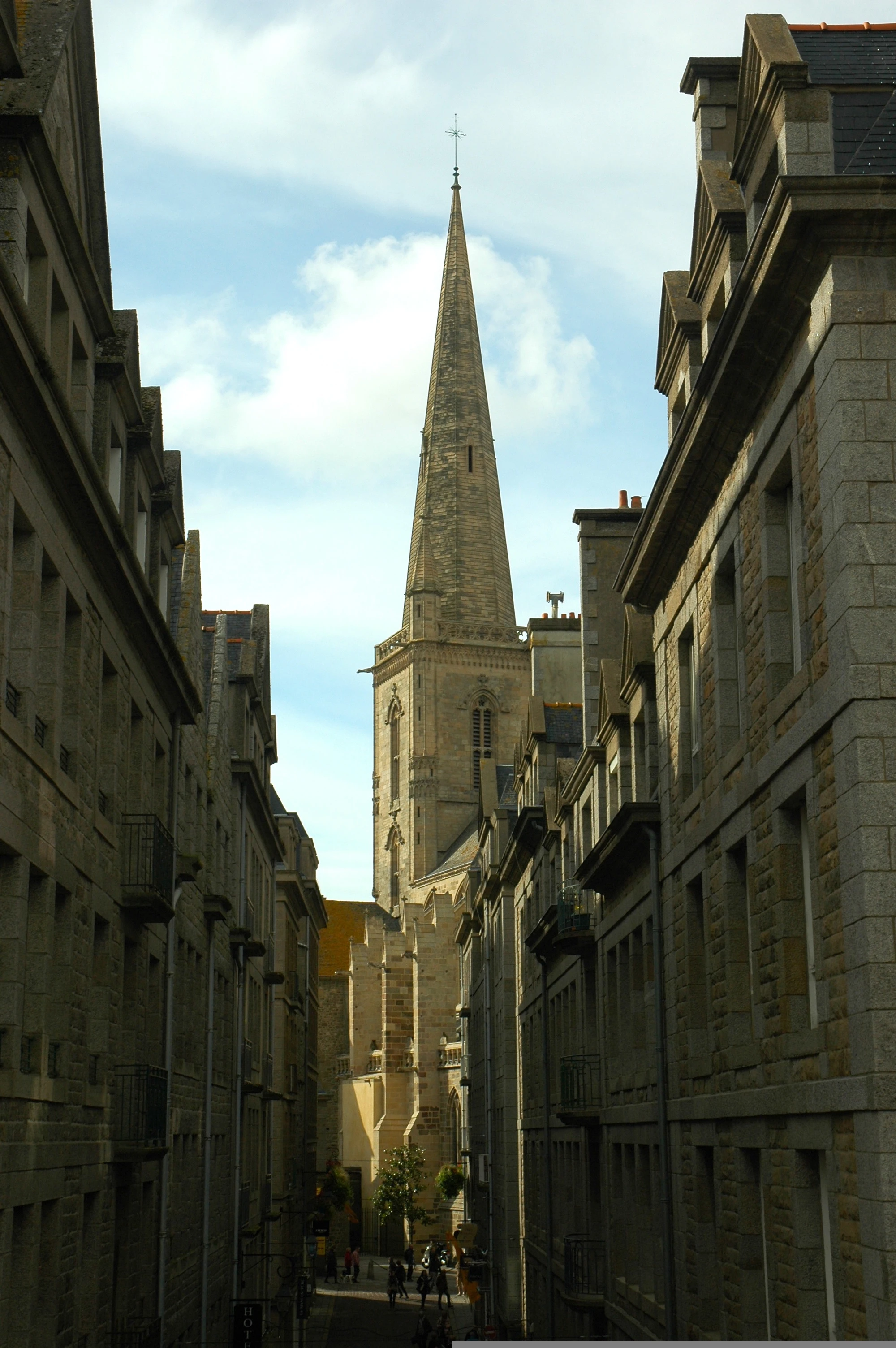 Saint Malo Cathedral and its distinctive bell tower, rebuilt after wartime destruction and completed in 1972. Photo chosen by monsieurdefrance.com: Image by Jens de Pixabay
Saint Malo Cathedral and its distinctive bell tower, rebuilt after wartime destruction and completed in 1972. Photo chosen by monsieurdefrance.com: Image by Jens de Pixabay
The seat of the bishopric of Saint Malo (which disappeared in 1790) since 1145, it is truly the emblem of Saint Malo, the heart of the town, and has seen many a Malouin life go by over the course of almost a thousand years. Surcouf and Châteaubriand were baptized here, and Jacques Cartier was laid to rest here. The church was badly damaged during the Second World War, but the oldest walls are Romanesque, the choir is Gothic, lit by stained-glass windows that create a beautiful bluish atmosphere, and the bell tower is the only tall element within the walls. It hasn't always looked this way. It was rather low until 1860, when a neo-Gothic spire inspired by Quimper Cathedral was added, which was destroyed by bombing in 1944 before being replaced by the one we know today, completed in 1972 and crowned with a cross in 1987. The bell tower houses the famous "noguette", the municipal bell that has been rung at 10:00 pm every evening since 1804.
The interior of Saint Malo Cathedral and its special atmosphere. Image chosen by monsieurdefrance.com: jjfarquitectosJJ via depositphotos.
Shopping and strolling along rue Saint Vincent, rue de la Barbinais etc...
Saint Malo is not just about the sea, far from it. It's been a city of commerce since the very beginning. The city of Alet was already a trading center for the Coriosolite Gauls, and Saint Malo's shipowners traded internationally to bring rare items such as spices back to Saint Malo. "Intra", as they say, is where you can store and indulge yourself at a number of original or highly reputed addresses, such as Maison Bordier, 9 rue de l'Orme, which makes the best butter in the world. A salted butter (normal in Brittany) that can be enjoyed plain and simply on a slice of bread, but also "flavored" butters, with seaweed for example. At 12 rue Saint Vincent, Roellinger presents an incredible array of spices from around the world.
You can also take a look at the street names, which are often original and even amusing, such as "la rue de la pie qui boit", the only French street to bear this name, which comes from a tavern whose wooden sign featured a magpie on a barrel of cider. "La rue du point du jour", the "rue des marins", reminds us that sailors were numerous in Saint Malo , and that they came here to celebrate their return to land after a campaign on privateer ships in the 18th and 17th centuries, or on the "terre-neuvats", the ships that took them out to fish for cod off Newfoundland in Canada. It was a risky business, and it wasn't unusual for some of them to never return. There's also the rue du "chat qui danse ", a reminder that a cat was the only victim of the infernal explosive machine launched by the English against Saint Malo. There are also streets reminding us of the existence of great Malouins such as Maupertuis (philosopher of the Enlightenment) and La Mettrie (physician and philosopher of the Enlightenment).
Drive past the historic houses of Châteaubriand and Surcouf
You can walk past the house where Châteaubriand was born. François René de Châteaubriand was born in Saint Malo on September 4, 1768, at 3 rue des juifs, now known as ... Rue Châteaubriand. Born in a storm, as he himself recalls in "Les mémoires d'outre-tombe", when he wrote: "The room where my mother gave birth overlooks a deserted part of the city walls, and through the windows of this room you can see a sea stretching as far as the eye can see, breaking on reefs (...).The roar of the waves, lifted by a gust heralding the autumnal equinox, prevented me from hearing my cries". You can't visit, but you can see the facade. Still intramural, you can walk past the house of Robert Surcouf, the most famous of the Malouin corsairs. Surcouf's birthplace, the Hôtel de la Bertaudière, 2 rue du chat qui danse, is not open to visitors either. On the other hand, you can visit the Corsair's home, the Hôtel d'Asfled, 5 rue d'Asfeld.
Photo chosen by monsieurdefrance.com: Photo Boards on Unsplash
What to see outside Saint Malo intramuros
Le Fort National
Situated in front of the historic city and the Sillon beach, it's called the Fort National, but was also called the Fort Royal in the days of the kings, and even the Fort Impérial under the reigns of the two Napoleons. Built in 1689 to Vauban's plans and on the orders of Louis XIV to protect Saint Malo, it was never taken when attacked. A prison during the Second World War, it held hostages during the fighting to liberate Saint Malo, and 18 prisoners were killed by American shells bombarding the town and the fort. It is said that Surcouf fought here against 12 Prussian officers during the Napoleonic Wars. Having defeated the first 11 soldiers, Surcouf is said to have stopped the fight, saying to the 12th adversary, "Let's leave it at that, if you please, sir. It is good that you can tell your country how a former soldier of Napoleon fights". It's probably not true, since the contemporaries and Surcouf himself don't mention it, but after all, as the saying goes, "you only lend to the rich"... You can visit it. It's open when the French flag is flying at the top.
The National Fort. Photo chosen by monsieurdefrance.com: depositphotos.
Le Grand Bé
Le grand bé at high tide. Photo chosen by monsieurdefrance.com pillerss via depositphotos
The bés probably take their name from "ford". It's hard to believe, but until the 11th century, the sea was farther away , and it was easy to get from the city to the bés, and even to cross some of the salt meadows that surround Mont-Saint-Michel today. Today, you can walk to the Grand Bé, and even to the Petit Bé, at low tide, but beware! The tide rises quickly, and you could find yourself stuck on the islets for 6 hours. The Grand Bé is the larger of the two bés. It's not built. Or rather, intense bombing in 1944 destroyed everything on it, including two chapels whose ruined walls can still be seen. Here lies the tomb of François René de Châteaubriand, who was laid to rest on July 18, 1848, at precisely 2.10 p.m., and whose story is also told here, along with that of the Château de Combourg, where he lived, just over 30 kms from Saint Malo and well worth a visit:
Le petit Bé
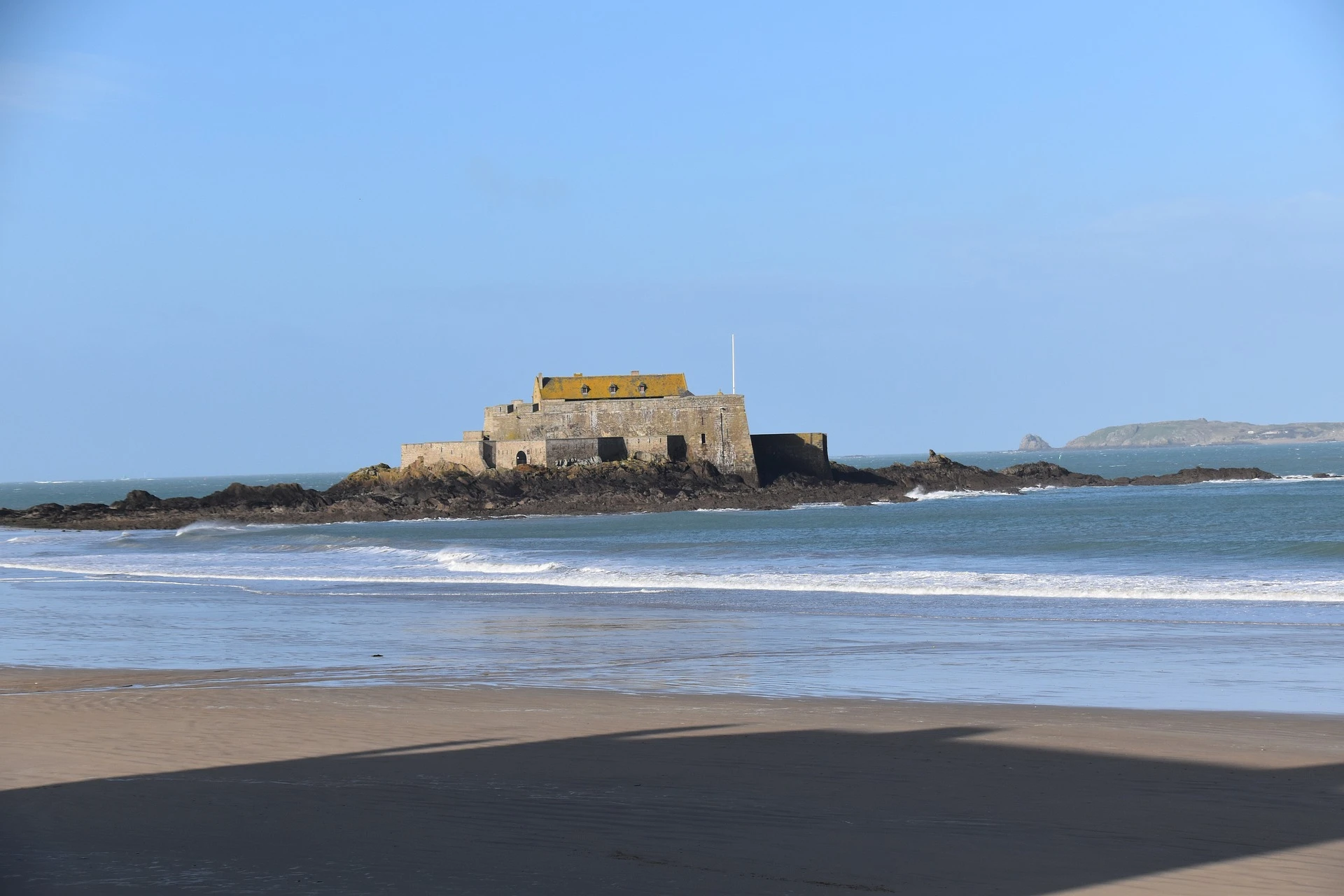 Le petit Bé. Image chosen by monsieurdefrance.com: Image by JackieLou DL from Pixabay
Le petit Bé. Image chosen by monsieurdefrance.com: Image by JackieLou DL from Pixabay
It's the smaller of the two Bé (yes, okay, you deduced it!). It is fortified. Designed by Vauban in the 17th century, the fort du petit bé was one of a series of forts built to defend Saint Malo. Other forts are still in place, notably Fort de la Conchée (a little further offshore) and Fort Harbour (off the coast of Dinard). Made up of a double building, one of which was on three levels, it could accommodate 160 soldiers. It has been renovated by enthusiasts over the years. It is now possible to sleep there.
Cézembre Island
Cézembre Island from Saint Malo. Photo chosen by monsieurdefrance.com: wjarek via depositphotos.
The island of Cézembre is located off the coast of Saint Malo. It can be reached by boat. There are regular boat connections. The island is just under 10 hectares in size. Inhabited since Neolithic times, it was a hermitage in the early Middle Ages, and is said to have been taken by Charlemagne himself when he tried to subdue the Bretons (but failed). Cézembre was long home to a monastery that welcomed King Charles IX, who was visiting Saint Malo, and was looted and destroyed during the English raid of 1693. In 1944, during the liberation of Nazi-held Saint-Malo, it was pillaged by the Allies (more than 20,000 shells, including the brand-new napalm and phosphorus shells). A large part of the island was closed to the public because of the mines that were still there until quite recently. This is the only beach on the north coast of Brittany that faces due south. A small, rustic restaurant overlooks the beach. It is now a protected natural area.
The furrow and its breakwaters.
This is Saint Malo's main beach. In the past, this sandy groove was often covered by water at high tide, isolating and protecting the town. Today, a dike built at the end of the 19thcentury is a popular walk for tourists and locals alike, from "intra" to the Pointe de la Varde. You'll come across the Thermes marins de Saint Malo (thalasso-therapy site), and a few pretty villas. You'll always be amazed by the "breakwaters", wooden piles planted in the sand (often more than twice their emerged height) to break the waves and protect the seawall.
Breakwaters. Some are more deeply dug than they are tall. Photo chosen by monsieurdefrance.com Photo by Nabih El Boustani on Unsplash
The Grand Aquarium
Inaugurated in 1996, it is located at the entrance to Saint Malo. It features over 10,000 animals, including more than 600 different species. It takes 2 hours to visit, and you'll be able to see the great sharks and sea turtles swimming in the heart of the ring of seas above you. It's quite beautiful... And scary. From 18 euros (rate 2023) for adults. All info here.
A shark to see at the Grand Aquarium de Saint Malo / Photo chosen by monsieurdefrance.Com: rebius sur depositphotos.
But also: Courtoisville, Saint Servan, Rothéneuf... There's so much to see
Saint Malo also boasts numerous viewpoints to discover: the sea is magnificent at Pointe de la Varde, Saint Ideuc and Rothéneuf. Also worth a visit is Saint Servan, a former commune with a lovely atmosphere, some charming little streets, a beach and the Tour Solidor, a keep that enabled the Dukes of Brittany to keep watch over the mouth of the Rance. You can also take a stroll around what remains of the Cité d'Alet fortress, and if you like architecture, take a stroll along the Courtoisville coast to discover the Belle-Epoque villas.
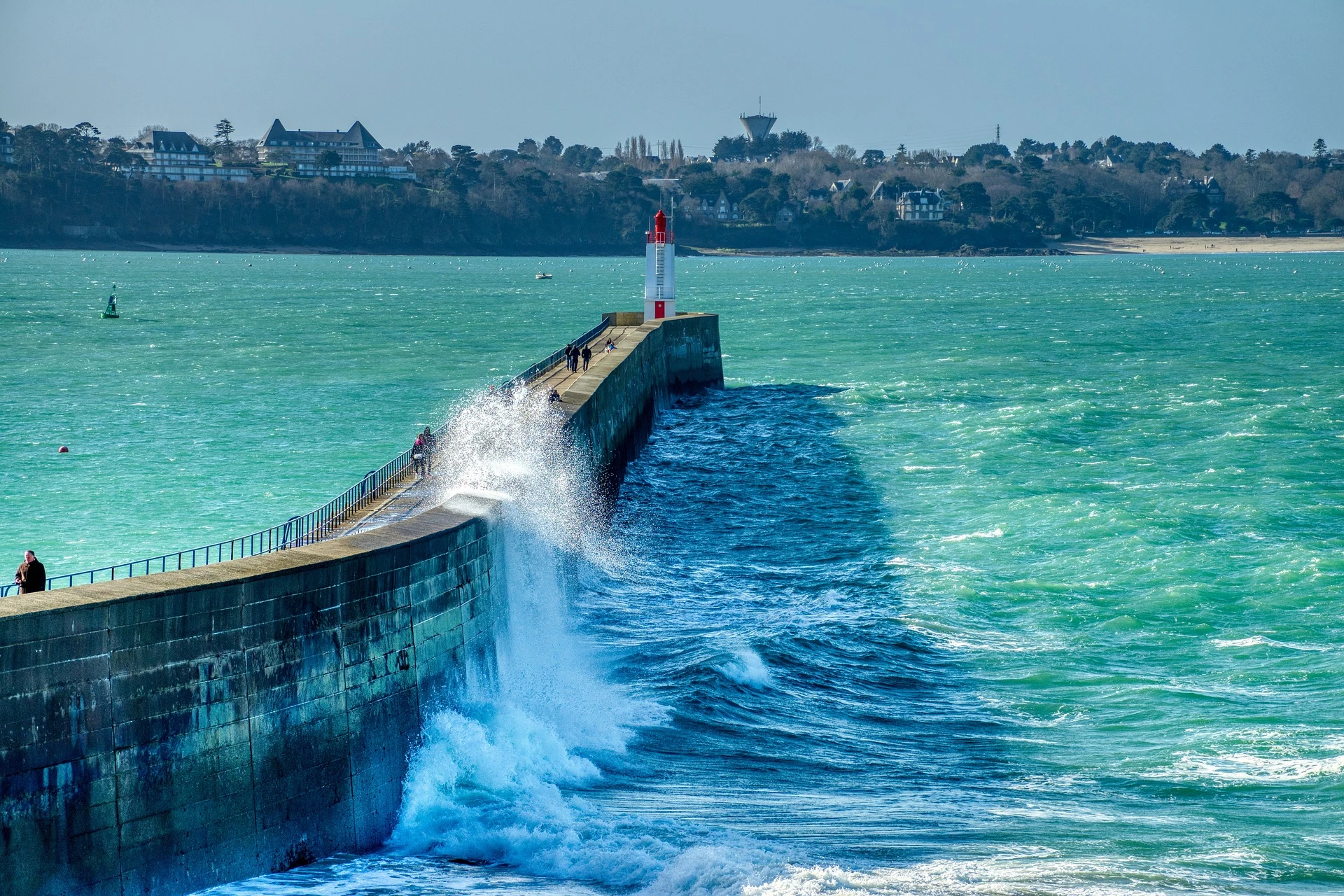 The môle des noires in Saint Malo. Image chosen by monsieurdefrance.com: Image by Thierry BEUVE from Pixabay
The môle des noires in Saint Malo. Image chosen by monsieurdefrance.com: Image by Thierry BEUVE from Pixabay
What you need to know about Saint-Malo
What are the inhabitants of Saint Malo called?
Don't talk to us about "saintmaliens" or "saintmalois" as we sometimes hear... In Saint Malo, the inhabitants are called Malouines and Malouins. And you'll see they're proud of it (with good reason!).
A city on a rock
The "original" town of Saint Malo was the city of Alet. With its back to the sea, it was located at the mouth of the Rance, an important trading site for the Gallic Coriosolite tribe. Further out to sea were several islets or rocks, including the rock on which the town of Saint Malo was built. By the end of the 9th century, Alet's inhabitants had understandably begun to abandon the town. The town was regularly raided by Vikings, and regularly pillaged. As a result, the inhabitants began to settle on the large rocky outcrop beyond. It has to be said that it had a number of advantages. Surrounded by "pebbles", even underwater, which prevented boats from getting too close if they didn't know the passes, connected to the land by a sort of thin strip of sand and earth covered by the sea at high tide, the rock offered great protection by being fairly isolated and difficult to attack both by sea and by land. From the 11th century onwards, this vast rock connected to the land took precedence over Alet, which was too exposed to attack, and it was here that the great and exciting adventure of the "corsair city " began.
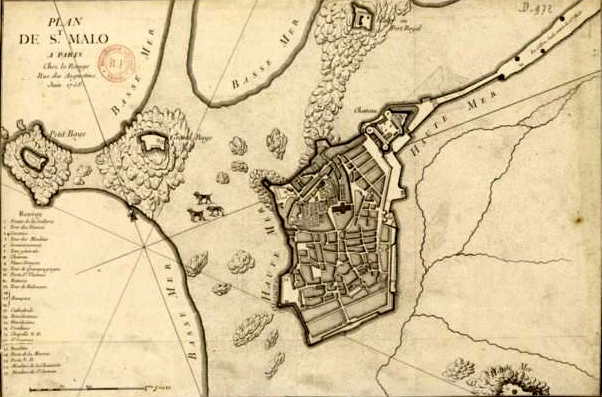
This 18th-century plan clearly shows Saint Malo (the original rock was enlarged at various times by colossal construction work) as a peninsula, linked to the mainland by the sillon (to the right of the city), surrounded by islets and rocks that make it difficult to approach if you don't know the way around these islets and underwater reefs.
Why "Saint Malo"?
Because Saint Malo lived there, on the rock. For a long time, the place was called Saint Aaron's Islet, because the saint lived there as a hermit, but it was Saint Malo, a Welsh traveler, who gave his name to the rock and thus to the town. If the old grimoires are to be believed, he's a pretty amazing fellow... There are absolutely no historical sources on this character, but the legends are numerous. Originally from Wales, he is said to have been the object of sea-related miracles from an early age. Legend has it that, as a child, he fell asleep on a rock that was regularly swallowed up by the tide, and that the rock rose so that the child would not be drowned in his sleep at high tide. When he grew up and became a priest, he sailed the sea for 7 years with his friend Saint Brandan, with the aim of discovering the "Islands of Fortune", near Paradise on Earth, and converting the barbarians. Still according to legend, Saint Malo arrived in Brittany and settled as a hermit with Saint Aaron, who was already living there, on the large deserted rock near the town of Alet (where Saint-Malo Intramuros is today) .
Saint Malo says mass with his friend Saint Brandan on the back of a whale he thought was an island Antique engraving. B.N.F.
The story could end there, but Saint Malo felt he couldn't "rest" and had to convert, so he took charge of the city of Alet, which still seemed pagan to him.There, he said mass and performed three miracles (restoring sight to a blind man, driving away the demon that had possessed a woman, and resurrecting a dead man).Amazed (and quite rightly so!), Alet's remaining Pagan population converted, and Saint Malo became bishop of the town of Alet.Very popular with the inhabitants of Alet, he was persecuted by a local warrior to the point of leaving his rock and moving to Saintonge (the name of the area around the town of Saintes in Charentes-Maritimes) with his friend Saint Léonce.His departure is said to have brought much misfortune to the city of Alet, and as a result, some inhabitants came all the way to Saintonge (422.1 km, after all! We looked it up) to beg him to return . An angel is said to have persuaded Saint Malo to be kind, forgive and return. Back in Alet, he is said to have restored peace and prosperity, before returning to Saintonge to end his days in 621 A.D. Saint Malo is celebrated on November 15.
Saint Malo flag and mottos.
The Saint Malo coat of arms
It features an ermine walking on a portcullis on a red background. In heraldic parlance, it's more accurate to say: "Gules (red), a portcullis Or issuant from the base, surmounted by an ermine passant Argent, the tip of the tail Sable, accolated Or and escarpé of ermine". In the complete coat of arms of the town of Saint Malo, the coat of arms is stamped (surmounted) by a gold mural crown, composed of the two large towers of the Grand'Porte, and it is "accolated", i.e. surrounded by two gold dogs that recall the story of the dogues that were released at night to bite anyone approaching the ramparts of Saint Malo. Under the coat of arms are the Legion of Honor cross on the right and the Croix de Guerre 1939-1945 on the left, a reminder of the city's sacrifice during the Liberation.
Saint Malo flag
It consists of a white cross on an azure-blue background, but on the upper left-hand quarter, it repeats the coat of arms on the upper left: an ermine running on a golden portcullis. This is the flag that culminates at the top of Saint Malo's keep, and also on the ships that set sail from Saint Malo, which are always very proud of this flag, which is often placed on the same level as the French flag to recall the former republic of Saint Malo. In fact, the town of Saint Malo refused to submit to King Henri IV of France because he was a Protestant, and formed a republic from 1590 to 1594 after the inhabitants of Saint Malo took the castle.
The official currency
"Semper fidelis" is Latin for "always faithful". It became Saint Malo's motto after the republic of Saint Malo and the city's return to the kingdom of France in 1594. It was a way of telling King Henri IV that he could once again count on the loyalty of the people of Saint Malo.
The other Malo motto:
"Neither French nor Breton: Malouin suis". It's said to date back to the Republic of Saint Malo (1590-1594). What's certain is that it really reflects the character of the people here: independent, enterprising, stubborn, they're Bretons it's true, French too, but when you get to know the people of Malouin and this astonishing town, you realize that there's a soul here, a special character, that will always make the people of Malouin unlike any other Bretons or French. Malouins, that is!
Great danes
You'll recall that for a very long time, the town was isolated from the mainland by a sort of isthmus that was covered by the tide several times a day. In addition to the walls and reefs that prevented ships from approaching the city if they didn't know the passes, the Malouins had the idea of having dogs guard the city. Fierce dogs, which only those who fed them could approach,were let loose at night on the other side of the ramparts. Thus, roaming around the town, they attacked anyone who came near Saint Malo. The noguette bell was rung in the evening to warn the inhabitants that the city gates would be closed and the dogs released. Numbering 24, they were abolished in 1772 after attacking an important person (who was said not to have heard the curfew, being busy with his mistress in Saint Servan).
Jacques Cartier: the man who discovered Canada
Jacques Cartier imagined by Theophile Hamel (1844).
Jacques Cartier was born in Saint Malo in 1491. Little is known of his past, but it is thought that he went to Brazil (he spoke Portuguese), but also probably off the coast of Newfoundland, where the Bretons were already fishing cod. In any case, it was as a navigator that he was introduced to the French king François 1er, on a trip to Mont-Saint-Michel (by Jean Le Veneur, owner of the Château de Carrouges, which we visited and present here). The king was persuaded to finance Jacques Cartier's expedition westward to discover new lands. France, it must be said, took a dim view of the Spanish and Portuguese sharing the New World. Jacques Cartier made a total of three expeditions: in 1534, 1535 and 1541. He sailed up the St. Lawrence River and discovered Canada. Jacques Cartier had no descendants. He ended his life in Rothéneuf, at the manor house of Limoëlou, where you can visit the Jacques Cartier museum dedicated to this great man, including the bedroom and dining room. He lies buried under a slab in Saint Malo Cathedral, where his remains were found in 1949.
Privateers
Privateers left their name to Saint Malo, the "corsair city". It has to be said that they brought glory to the town by pursuing the ships of nations with which France was at war. Above all, they boarded and plundered merchant ships on behalf of the king, who gave them a letter of marque authorizing them to do so in exchange for a percentage of their revenues to be paid to the State. A small percentage at times, since many corsairs managed to deposit part of their booty in offshore islets, only to return to collect it after the king's agents had checked it. These corsairs were very famous and respected, even by Louis XIV himself, who nicknamed them "ces messieurs de Saint Malo". But don't confuse them with pirates - they're not the same thing, and you'll alienate the people of Saint Malo.
Surcouf, the most famous privateer from Saint-Malo (with a seagull!) photo chosen by monsieurdefrance.Com: pixavril via depositphotos
Les malouinières
The wealthy shipowners of the 17th and 18th centuries liked to have, in addition to their homes in Saint-Malo, a "country house", i.e. a château or manor house in the countryside, where they went in fine weather and where they entertained a lot. These châteaux are classical in style, a little austere at times, and their interiors are often surprising: offering visitors a glimpse of objects and decorations reminiscent of the Malouin shipowners' dealings with the world of their time. There are 112 around Saint Malo. Not to be missed are the ville-bague at Saint Coulomb (where receptions can be held), the chipaudière (where you can rent a longère near the château) and the Montmarin, at La Richardais, on the other side of the Rance from Dinard. A magnificent château with gardens that are a must-see.
La Malouinière de la Chipaudière. Image chosen by monsieurdefrance.com: by packshot via depositphotos.
"Port Malo": when Saint-Malo changes its name.
During the French Revolution, Saint Malo was a resolutely republican island in the middle of a rather Chouane Brittany, in other words, against the Revolution. Like many communes, Saint Malo changed its name in 1794, at a time when attempts were being made to erase all traces of the monarchy and the Catholic religion. Saint Malo became "Port Malo", Saint Servan "Port Solidor". Mont-Saint-Michel itself changed its name to "Mont Libre" (at the same time as it became a prison, which is not without contradiction). Many of the city's streets and monuments were renamed. The Porte Saint Vincent became the "Porte des Sans-Culottes", while the Porte de Dinan became the "Porte de l'Egalité". Streets were renamed, such as rue Sainte Barbe, which became "rue de la fidélité" , or rue Saint Philippe, which became "rue de la probité". Even the bastions changed their names. The bastion Saint Louis became "bastion de la vigilance" and the bastion Saint Philippe became "le bastion de la vaillance" .
The "terre-neuvas
For a very long time, Saint Malo was one of France's biggest cod fishing ports . Sailors, recruited from the town but also from all around Saint-Malo, would embark on a fishing campaign lasting 6 months. It was an extremely dangerous job that took them all the way to Labrador, off the coast of Newfoundland, to fish for cod. The weather conditions, the risky work in boats in the middle of the raging ocean, the hygiene, and the journey punctuated by storms cost the lives of many sailors. And the walls are sure to recall the women and families who learned of the death of a loved one when they didn't get off the boat in port.
Terre-neuvas departing from the port of Saint Malo. Illustration chosen by monsieurdefrance: JPitois/creative commons.
Sea bathing and the Belle Epoque
The end of the 19th century saw the emergence of the sea bathing craze. Originating across the Channel, the desire to bathe for good health spread to France, and Saint Malo in particular. The first wealthy tourists arrived during the summer months. They built beautiful villas for their stay in Saint-Malo (magnificent ones can still be seen in the Courtoisville and Sillon areas). Saint Malo became a seaside destination. The arrival of the train in 1864 further boosted the town's success. Chic also became popular with the introduction of paid vacations in 1936. Its success has never waned since. Opposite, Dinard was born of this craze for this beautiful part of Brittany, which stretches from Saint Cast to Cancale and has been dubbed the "Emerald Coast". If you want to impress, you can always say that "côte d'émeraude", like "côte d'Azur", is a choronym, in other words, according to Wikipedia, "a name of a place or region derived from a physical geographical feature or an environmental particularity", in this case the emerald color of the water (due to the numerous algae).
Destruction and reconstruction
In 1944, Saint-Malo was one of the strongholds of the Atlantic Wall designed by the Nazis to prevent any landings in occupied Europe. The city of Alet was at the heart of a system designed to prevent the capture of Saint Malo. Bunkers and blockhouses were set up on the Grand Bé, on Cezembre Island, as well as opposite Dinard. In August 1944, General Patton's 3rd US Army landed in Normandy, headed for Brest and laid siege to Saint-Malo. The town received its first shells. Some fell on the Fort National, where hostages had been taken, killing 18 Malouin prisoners (a plaque in the fort pays tribute to them). On August 9, the bombardments became much heavier, lasting 2 days, and a large part of the old town, particularly the woodwork, burned to the ground. A week later, on August 14, 1944 , 150 American bombers bombed Saint Malo, destroying more than 80% of the town, mainly Intramuros, notably the Château, but also the Grand Bé and Cézembre. Saint Malo was liberated on August 17, 1944. The town was in ruins.
Saint Malo Cathedral destroyed by bombing. Photo chosen by monsieurdefrance.Com Editions du Greff Paris via Musée de Bretagne.
By 1945, 683 of Saint Malo's 865 buildings had been destroyed or damaged, and more than 2,000 housing units were missing. The town was to be rebuilt, under the leadership of mayor (and minister) Guy La Chambre, after the people of Saint Malo insisted that it should be rebuilt in its original style. The foundation stone was laid at 9 rue d'Estrées on January 26, 1947, after 18 months of work by 300 men to clear over 500,000 M3 of ruins. The reconstruction aimed to restore the general appearance of Saint Malo, and some buildings were rebuilt identically, at least for the facade, thanks to the numbering of the stones. The historic town has been modernized (notably in terms of networks), and its streets enlarged, but it has kept its tall, high-roofed houses. The cathedral has been restored. By 1957, 98% of the city had been rebuilt, but it wasn' t until 1972 that the cathedral project brought the 25-year reconstruction period to a close .
Neighborhoods that were once communes
The Saint Malo of today, with its 50,000 inhabitants, is not exactly the same as it was yesterday. Over time, a number of communes joined Saint Malo and made it bigger. Paramé and Saint Servant merged with Saint Malo in 1962, doubling the commune's population. With Paramé, the hamlet of Rothéneuf and its coastline also became part of Saint Malo, as did the village of Saint Ideuc, which had already been attached to Paramé in 1792. Each of these former communes has kept its own church and town hall, and these parts of Saint Malo continue to be referred to by the name of the former commune.
Culinary specialities
Seafood, of course. Bouchot mussels from the Bay of Mont Saint Michel are often on offer, as are the famous oysters from neighboring Cancale. You'll also find scallops picked not far away, in the Bay of Saint Brieuc or near Erquy. You'll also find blue lobster, spider crab and crab cakes, all delicious in court bouillon. Saint Malo is also the land of salted butter, since it's in Brittany, and it's here that the best is made, at Bordier. You're bound to find Breton crêpes here (although crêpes here are called galettes if they're salted), and it's well worth making a little complete galette (ham, cheese and egg) on your way back from the beach. There are plenty of restaurants on the coast. Don't hesitate to ask the locals for recommendations, they'll be happy to help.
Our favorites
Chez Lucile" hair salon.
Opposite the station. Modern, warm, super-convenient, a great place run by Lucile and her team.
Address: 21 rue Nicolas Bouvier.
Mystère et Compagnie
Intramuros. Here you'll find the entire Harry Potter universe and the rarest Harry Potter items. From the famous wand to the nimbus 3000 and House outfits. Not to be missed with the kids.
Address: 2 place Brevet.
Geotrain web info
Geo :
Saint Malo is located in the Ille et Vilaine department, in the Brittany region. It is about 70 kms from Rennes (less than 1 hour's drive), 1 hour from Granville, 417 kms from Paris (4 hours' drive via the A11, A81, D137).
Train :
The town is served by a T.G.V. station. It takes an average of 2 hours 45 minutes to reach Paris. There are an average of 13 trains a day. To find out more, click here.
Plane :
You can fly to Saint Malo from Rennes Saint Jacques or, more rarely, from Dinard Pleurtuit.
Websites
The official Saint Malo Tourisme website is very well designed, with maps and itineraries in and around Saint Malo. The offices are located on the esplanade near the Porte Saint Vincent.
And don't hesitate to visit Saint Malo Rama .
Here are the official websites
Sorry for any mistranslations, but our translator was celebrating in Saint Malo (an old tradition here!) and was unable to translate, so his grandmother from Dinard did the work.
Mont-Saint-Michel is not far away: here's our visit and advice.
FAQ
What are the must-see attractions when visiting Saint-Malo?
Among the must-see sites are the ramparts, Fort National, Grand Bé, Saint Vincent Cathedral, and Rue Saint Vincent.
How do I get to Saint-Malo from Brittany?
Saint-Malo is accessible by train via Saint-Malo station, or by car via the N176/N137 depending on your starting point.
How much does it cost to visit the ramparts of Saint-Malo?
Access to the ramparts is free; some forts or museums may charge an entrance fee.
Can you visit the islets around Saint-Malo?
Yes, you can access Grand Bé at low tide; Petit Bé and Cézembre Island are accessible by boat and depending on tide conditions.
When is the best time to visit Saint-Malo?
The best time to visit Saint-Malo is from May to September, when the weather is favorable and summer activities are in full swing.

